- Skip to primary navigation
- Skip to main content
- Skip to primary sidebar
- Skip to footer
Yacht Cruising Lifestyle
Everything fun you can do from your yacht

20 Blue Water Cruising Catamarans Under $100k
October 13, 2021 by Martin Parker 1 Comment
The debate between single-hull sailboats and blue water catamarans has raged since the beginning of time, and it’s unlikely ever to end! Both types of yachts have dedicated followers who are unlikely to ever be swayed by the benefits of the other. A lot of this is based on misconceptions and the influences of the people around them, though. We recommend that if you’re considering a blue water catamaran, get in a few good hours of sailing through varied conditions before making a decision.
What Makes Blue Water Catamarans Great for Cruising?
Stable platform s.
Bluewater catamarans offer fantastic stability, despite what you may hear from single-hull yacht owners. There’s no high lean angle when sailing into the wind and no need to strap everything down to prevent it from moving. Add to this little or no rolling when moored, and a catamaran is a lovely place to be.
Additional Space
An excellent beam to length ratio is essential on bluewater catamarans, and a 40-foot yacht will usually have a 20-foot beam. That gives you a 20-foot bridge deck, plenty of space on the hulls, and even more space forward on the netting.
Cruising Speed
The amount of wet surface area on a catamaran is significantly reduced compared to a monohull yacht. Without the need for a prominent, heavy keel for ballast, the catamaran can easily outperform a single hull yacht.
Shallow Draft s
Shallow draft boats allow easy navigation through shallow waters and exceptional stability for maximum comfort. You are far less likely to make mistakes with tide height predictions when sailing on a cat.
Enclosed Cockpit s
Bluewater catamarans virtually always have an enclosed cockpit. Not only does this shield you from the sun in winter, but the elements in winter making cruising far more comfortable.
Safety
The enclosed cockpit makes sailing safer, plus of course, when you need to get out on the deck, the stable catamaran is not pitching and rolling.
Our Top Choices For Blue Water Catamarans Under $100,000
Designed and built by Rajen Naidu, the Rayvin 30 is a 29.5-foot cruising catamaran built for comfort. With a draft of just one meter, there are few places you can’t go on the Rayvin. The hull is constructed of epoxy glass fiber, but carbon-kevlar has been used for added strength below the waterline.
Inside, you’ll find three cabins, plenty of space, and even a bath! These are great value blue water catamarans with excellent performance.
Prout Snowgoose 37
Probably one of the most well-known blue water catamarans available, the Snowgoose 37 was designed and built by Prout and Sons in the United Kingdom. With a displacement of 6 tons, this is not a light boat, but the 600 square feet sail area gives a healthy hull speed of up to 10 knots. Many people have completed a circumnavigation in a Snowgoose.
It has a cutter design, but the overhang is substantial, leaving it susceptible to bridge slam, particularly on a close reach.
Over 500 examples were built, with plenty available under the $100,000 mark.
Prout Quasar 50
Sticking with Prout, the Quasar 50 was the largest catamaran designed and built by the company. The company was still making the Quasar until its closure in 2020, so you can find plenty of examples.
Constructed with fiberglass, the cutter design has a displacement of 10 tons and a sail area of almost 1185 square feet, giving a maximum hull speed of around 14 knots.
It has to be said the Quasar is not a pretty boat, but it makes a perfect large cruiser.
Catalac 12M
Catalac was a British boat building company owned by Tom Lack, hence the Catalac name. Over 600 examples of Catalac’s (9M, 10M, 11M, and 12M) were built. All around, they’re known as solid boats that handle well.
Designed as a sloop, the 12M displaces almost 9.3 tons. With a sail area of just 700 square feet, this cat offers a relatively slow hull speed of 9.5 knots.
An interesting point is the double thickness hulls, designed to withstand the North Sea weather.
Maldives 32
The Maldives 32 is a more modern design by Joubert-Nivelt. It features a short overhang with a netting deck to avoid bridge slam, initially built by Fountaine Pajot in 1988. The Maldives has a light displacement of 3.3 tons thanks to the fiberglass and foam sandwich construction. Add in a sail area of 592 square feet, and the Maldives can cruise at up to 11 knots.
The Maldives 32 is an excellent basic boat readily available well under our $100,000 price point.
Edel Cat 33
Thanks to the fiberglass construction, the Edel Cat 33 is another light boat, at just 3.6 tons and with a shallow draft of just 2.6 feet.
The Edel was designed by Yvonne Faulconnier and built by the Edel company in France, with the first bots being produced in 1985.
The 635 square feet of sail is enough for a good turn of speed for such a light boat without over-powering the hull.
A notable feature is the very short bridge hull, avoiding almost any bridge slam problems.
Endeavourcat 30
Designed by Cortland Steck and built in America by the Endeavour Catamaran Corp, the Endeavourcat 30 is a lightweight 30-foot catamaran constructed using fiberglass with a foam core.
It has to be said; the Endeavourcat is not pretty, but you get a lot of space for your money. Another issue is the enclosed bridge deck, making this suitable for gentle cruising only.
The sloop-rigged catamaran is a good, reasonably priced starter boat for taking the first dip into blue water catamarans.
Island Packet Packet Cat 35
If you are looking for comfort with a bit of style, then the Island Packet Cat 35 could be it. Designed by Robert K. Johnson and built in the USA by Island Packet, the Cat 35 makes the perfect boat for cruising the Keys.
The displacement of 6.25 tons gives the boat a solid, dependable feel, while the 2.6-foot draft allows you to explore water-restricted areas.
Inside there’re acres of room, but the fully enclosed bridge deck will cause issues in heavy weather.
Gemini 105MC
The Gemini 105MC is a sloop-rigged boat designed by Tony Smith and built by Performance Cruising in the United States. It was in production for over 27 years, and they delivered over 1000 boats, so there are plenty available to suit most budgets.
An interesting design feature is a lifting centerboard, giving excellent stability when down but a draft of just 1.65 feet when lifted.
A displacement of 4 tons combined with 690 square feet of sail area gives the 105MC outstanding performance characteristics.
With 760 examples of the Lagoon 380 produced, there are plenty on the market at reasonable prices. Built by Jeanneau, it is one of the most popular bluewater catamarans ever made.
The distinctive vertical windows offer maximum internal space, and it has a spacious interior, but the tradeoff is a displacement of 8 tons, so performance suffers a little. You can cruise comfortably at 7 knots, and with the short bridge deck, you won’t suffer too much bridge slam.
If you can track down a Dean 365, it’s well worth a look. You can find these solidly built boats for $50,000 upwards. Designed by Peter Dean and built by his company, Dean Catamarans, they have an excellent reputation.
For a 36 foot boat, the 6-ton displacement is not light, but it does benefit from twin engines, and with the sloop rigging, it can sail downwind at up to 11 or 12 knots. With the genoa providing the main sailing power, sailing into the wind is not great.
Sold as a self-build design, the Tiki 38 is a solid cruising catamaran designed by James Wharram. There are plenty available, but all will be different depending on the builder. With a displacement of around 6 tons, it’s not the lightest, and the cruising speed is about 5 or 6 knots.
With a ketch rig, using two 30-foot masts, the sail area is around 730 square feet, but you can also use a 530 spinnaker. The draft is shallow at 2.5 feet.
The Tiki makes an interesting – perhaps quirky choice.
Crowther Spindrift 40
If you are more interested in performance than interior space, the Crowther Spindrift 40 could be an excellent choice. Designed by Lock Crowther, the Spindrift features narrow hulls, reducing the wet surface area and increasing your sailing speeds. The downside is a lack of space.
The sloop rigging gives you a total sail area of 791 square feet combined with a light 4-ton displacement, making the Spindrift excellent in light winds.
MacGregor 36
Three hundred of the Roger Macgregor designed 36-foot boats were built, so there are plenty available. It’s built as a racing catamaran, so space is at a premium. There is only a trampoline between the two hulls, but the weight saving makes the displacement just 1.4 tons, and with the 534 square feet of sail, you can achieve speeds touching 28 knots.
Accommodation is restricted to the two hulls, but there are bunks for four people and a galley in the starboard hull.
The Flica 36 was designed by Richard Wood is a proven design capable of crossing oceans. A displacement of 5 tons gives a good balance between speed and stability, and the cutter rigging allows for a main and two foresails.
The hulls have been made from ply and fiberglass, which accounts for the slightly heavier weight and strength. The bridge deck offers plenty of space with a small overhang but will suffer from bridge slam in heavier weather.
Mirage Yachts 37
Only a few of the open deck Mirage 37’s were produced, but consider them in your search. Designed by David Feltham and built by Thames Marine, the ketch-rigged boats are sturdy and safe.
At 7.3 tons, it’s heavy for a 36-foot cat, and the small sail area of just 548 square feet makes it slow, with a hull speed of only 7.4 knots. As a coastal cruiser, it certainly makes sense to give you a comfortable base for exploring.
Simpson 35 Wildside
The Simpson 35 Wildside is an excellent cruiser, with three double cabins, two of which are across the bridge deck. Roger Simpson is the designer, and he’s well known for his sturdy, reliable boats.
The Bermuda rigged sloop design features a fully covered bridge deck, so expect bridge slam if you sail in anything more than slight to moderate conditions. With a displacement of 5
tons, and a small sail area, the performance will never be exciting, but it’s okay for coastal cruising.
Gemini 3400
The Gemini 3400 is the predecessor to the Gemini 105 mentioned earlier. If you can’t find a 105 at your price, then a 3400 is a good alternative. Although weighing the same as the 105, at four tons, the sail area is smaller at just 490 square feet, giving a reduced performance.
As with all Geminis, the 3400 features retractable centerboards for better tracking when on a close reach, without increasing the draft.
The 3400 was designed by Tony Smith and built by Performance Cruising in the US, who still produce catamarans now.
Seawind 850
Originally built in Australia by Seawind Catamarans and designed by Scott Jutson, the 850 is a 28-foot cat featuring fractional sloop rigging. At a relatively light displacement of 2.4 tons, the 350 square feet of sail gives good performance and comfortable cruising.
The short bridge deck overhang is filled with a trampoline, allowing the 850 to sail in rougher weather without too much bridge slam. The Seawind makes an excellent cruiser despite its 28-foot LOA.
Aventura 23.5
Our last catamaran is the smallest in the review. The Aventura 235 is just 23 feet long, has a light displacement of only 0.77 tons, and a sail area of 312 square feet. Two cabins offer four berths despite its diminutive size, making it a comfortable cruiser for a small family.
There are, of course, compromises, with just a single outboard engine on the centerline, and internal space is limited. But with its lightweight design, easy handling, and shallow draft of 1.8 feet, it is a perfect first step into catamaran ownership.
Blue Water Catamarans Are a Fantastic Budget Option
Remember: When buying a bluewater cruising yacht for less than $100,000, compromise is inevitable.
The best advice for buying a boat is to be truly honest with yourself by defining your needs and separating them from your desires.
Need more advice on buying great blue water catamarans? Get a conversation started on our community forum by leaving a question or comment!
If you found this article helpful, please leave a comment below, share it on social media, and subscribe to our email list., for direct questions and comments, shoot me an email at [email protected].
Sharing is caring!
Reader Interactions
July 2, 2022 at 2:52 pm
Surprised you don’t list the PDQ 32.
Leave a Reply Cancel reply
Your email address will not be published. Required fields are marked *
Save my name, email, and website in this browser for the next time I comment.
MB #20512 PO BOX 480 Sevenoaks Kent TN13 9JY
Tel: +44 56 0386 9163
Keep In Touch
Thank you for reading.
Join our online crew and find more about the #boatlife
SEAWIND 1370
Light and nimble through meticulous design and advanced lightweight construction - but crucially, capable of being heavily loaded with the minimum of impact on performance, this cruising catamaran brings about a generational step forward in catamaran design. the 1370 is built to a well-defined balance of sea handling performance and live aboard comfort demanded by modern cruising sailors., designed for shorthanded couples, the perfect balance of performance & ergonomics.
Seawind Catamarans deployed countless thousands of man-hours in hull design and optimization, and spared no expense in refining the crucial sailing ergonomics suited to a modern cruising couple. The new 1370 catamaran model has the high aim of striking the perfect balance between performance and comfort in a 45’ bluewater cruiser – this catamaran is designed to be the best go-anywhere, live-aboard cruising sailboat available today. Our rigorous design efforts have produced a hull capable of truly thrilling light air and heavy weather speeds and impressive pointing ability while being easy to handle shorthanded or single-handed.
BLUEWATER CRUISING IN UNRIVALLED COMFORT
The best of both worlds high specification with craftsmanship.
This all-new catamaran is equipped with all of the modern necessities, while employing true boatbuilding craftsmanship at every level. The 1370 catamaran model is fitted with exquisitely crafted carpentry throughout, complimented by a well balanced saloon that is bathed in bright natural light and ventilating airflow thanks to Seawinds famed tri-fold door and essential fwd opening window system. The comprehensively equipped galley comes standard with bar fridge, large 130l chest freezer, and an abundance of storage, making it ideal for extended cruising and responding to sailing couples with varying needs for toys and equipment on their own unique voyage.
THE PERFECT BALANCE OF PERFORMANCE & LIFESTYLE
Open-plan living, with saloon, galley, cockpit and helms all on one level, this catamaran boasts incomparable open living area. But not content with ticking all of the boxes, the 1370 catamaran model advances one step further with another Seawind first – the innovative new breakfast (or evening) bar with integrated seating. It will make taking that first rest after a day of fast sailing a truly simple pleasure and serve as a coffee area in the morning when you’re ready to get going. The 1370 includes an integrated cockpit BBQ and sink, as well as foredeck and cockpit lounges.
SAFE & PROTECTED HELMS
This single-level cruising catamaran boasts Seawind Catamarans’ indispensable twin protected helms which offer skippers complete protection and 360 degree visibility. Sheets, reefs and halyards are all led aft to electric sheet winches at the helms making rough, offshore passages more comfortable and achievable from the safety of the dry and protected cockpit.
FAST & EFFICIENT HULL DESIGN
The perfect balance of performance & safety.
For this new catamaran model, striking a balance between performance and safe, comfortable sea keeping has been of utmost importance. The lightship boat weighs in at only 11 tonnes – incredibly light and nimble for a significantly spacious 45-footer, but crucially the 1370 is capable of being heavily loaded with only the minimum of impact on sailing performance. Countless hours have been invested in Computational Fluid Dynamic (CFD) studies in order to discover the best balance of speed, and comfort under sail enabling Seawind to favor robust systems such as mini keels and spade rudders whilst not sacrificing on cruising performance.
THE BLUEWATER CATAMARAN FOR ADVENTUROUS SAILORS
Adopting all of the best advances made in the last decade of catamaran designs, and incorporating countless innovations in hull dynamics, structural engineering, exotic composite materials and manufacturing methods, where other Seawind Catamarans have been built tough - the 1370 will be bulletproof.
We have taken the feedback of hundreds of existing catamaran owners and sailors, and combined them with the practical experience and build principles of our senior shipwrights, to create a sailboat design and structure that perfectly merged these two perspectives.
The impressive reverse bows on the Seawind 1370 aren’t just a show piece. They are central to this catamaran design, by way of targeting the wave-piercing aspect to their effectiveness in reduce pitching, this hull design provides enhanced sailing comfort and safety through a smoother and more stable ride.
Seawind 1370 ticks all of our boxes
A performance-oriented, safe, bluewater-capable catamaran that is large enough to carry a payload for extended cruising but manageable by two people... The Seawind 1370 ticks all those boxes..." - Sailing Yacht Ruby Rose on the announcement of the new Seawind 1370

SPECIFICATIONS
Overall length, 45' / 13.7 m, 24'11" / 7.6 m, 4'3" / 1.3 m, displacement, 24,250 lbs / 11 tonnes, diesel saildrives, 2 x 40hp yanmar, 155 us gal / 600 litres, fresh water, 1,248 sq ft / 116 sq m, 861 sq ft / 80 sq m, 387 sq ft / 36 sqm, recommended options.

DUAL YANMAR ENGINE CONTROLS - ELECTRICAL

A second engine control mounted at the stbd helm makes for easy maneuvering and makes the boat manageable from either helm. Combined with the upgrade to electronic actuators this makes for effortless control and simple switching between helms.

BATTERY LITHIUM UPGRADE (800AH)
Change from the traditional AGM battery system to a high capacity Lithium system from Mastervolt. This option not only upgrades the batteries but also modifies the entire charging system ensuring a total compatible system including upgraded mastervolt alternators and regulators, additional AGM start battery and DC/DC charging unit.

SATELITE PHONE/DATA WIFI ROUTER IRIDIUM GO
The Iridium GO! is a satellite wifi router/phone. Once installed in the boat the boat will have a wifi hotspot the same as any office/home and all devices (phones, computers, chartplotters, c-zone etc) can then easily be connected to the internet.

B&G forward Scan option
Explore poorly-chartered or unfamiliar waters confidently, avoid upcoming dangers or obstructions and set custom shallow depth alarms with B&G’s forward-looking sensor. With an effective range eight times the actual depth, ForwardScan® helps you avoid groundings or damage to keels and rudders while pinpointing the ideal spot for anchoring.

C-ZONE DIGITAL SWITCHING
The sleek CZone® touch screen digital switching system provides a lightweight sophisticated switching system enabelling control and monetoring of your vessel through the navigation tables touch screen display or through WiFi connection the system can also be controlled at the helm mounted chart plotter or wirelessly via tablet or smartphone.
- Seawind 1370 Hull 1 Test Report
- New Production Facility and European Service Center in Izmir, Turkey.
- Seawind 1600 Reviewed by Pacific Yachting
- Seawind Blog
- Charter A Seawind
- Find A Dealer
- Français ( French )
Tel +84 28 3873 3630
Sales Enquiry:
Customer Service Enquiry:
© 2024 Seawind Group Holdings, Pty Ltd. All rights reserved.
Privacy Policy
- Embarking on a Seafaring Odyssey: Exploring the World of Bluewater Yachts and Cruising Sailboats
Are you ready to embark on a seafaring odyssey that will take you across the endless expanse of the open ocean? If the thought of navigating the deep blue waters on a luxurious boat has always been a dream, then you're about to set sail on an exciting journey. In this comprehensive guide, we'll dive deep into the captivating world of bluewater yachts, sailing on top-tier vessels, and the exhilarating thrill of ocean-going expeditions. Whether you're an experienced sailor seeking new horizons or a novice with a thirst for adventure, this article is your compass to the enchanting realm of maritime exploration.
Introduction
Imagine yourself standing at the helm of a majestic vessel, the wind whispering tales of distant shores, and the gentle rhythm of waves inviting you to set forth on a voyage of a lifetime. The allure of bluewater yachts encapsulates the essence of exploration, luxury, and freedom on the open sea.
Unveiling Bluewater Yachts: Masters of the Sea
Bluewater yachts are the maritime marvels designed to conquer the unpredictable waters of the open ocean. These vessels are engineered with a focus on resilience, safety, and comfort, making them the ultimate choice for those with a passion for venturing beyond the horizon.
Sailing Zenith: Reaching the Pinnacle of Seamanship
At the zenith of sailing prowess, a phenomenon known as the "sailing top" awaits the intrepid mariners. This pinnacle of seamanship represents the epitome of skill, where sailors harness the wind's energy to achieve unprecedented speed, precision, and navigational mastery.
Bluewater Yachts: Where Power Meets Elegance
The allure of bluewater yachts lies not only in their capacity to brave the open ocean but also in their opulent interiors and cutting-edge features. These vessels seamlessly blend power and elegance, offering a harmonious blend of performance and comfort.
Conquering the Vastness: Ocean-Going Yachts in Focus
Ocean-going yachts are the true conquerors of the sea, designed to tackle extensive journeys across the world's oceans. These vessels boast advanced technologies, robust construction, and top-notch safety measures, ensuring a smooth and secure passage, even in challenging conditions.
Oyster 56: A Symphony of Luxury and Performance
Amid the realm of bluewater yachts, the Oyster 56 stands as an emblem of sophistication and performance. With its impeccable balance of luxurious interiors and exceptional sailing capabilities, this yacht represents the zenith of modern maritime engineering.
Read our top notch articles on topics such as sailing , sailing tips and destinations in our Magazine .
Navigating Blue Water Sailing: A Journey Beyond Horizons
Blue water sailing transcends the ordinary. It's a calling to embrace the unknown, revel in the ebb and flow of the tides, and cultivate a profound connection with nature. It's an experience that fosters self-discovery while immersing sailors in the grandeur of the world's oceans.
Market Insights: Bluewater Boats Await New Captains
For aspiring sailors, the market offers a treasure trove of bluewater boats, each with its unique blend of features and capabilities. From sleek sloops to robust ketches, these vessels cater to varying preferences and aspirations, ensuring a perfect match for every seafarer.
Sailing the UK Waters: Blue Water Yachts on Sale
In the United Kingdom, the dream of owning a bluewater yacht is well within reach. The market showcases an array of blue water yachts available for sale, providing enthusiasts with the opportunity to explore the British coastline and beyond in style.
The Bluewater Dilemma: Making the Perfect Choice
The decision to select the ideal bluewater yacht requires careful consideration. Factors such as size, layout, amenities, and budget play a pivotal role in ensuring that your chosen vessel aligns with your seafaring ambitions.
Sailing Redefined: Thriving Aboard a Blue Water Catamaran
The blue water catamaran introduces a paradigm shift in sailing dynamics. With enhanced stability, spacious living areas, and shallow-water accessibility, these vessels redefine comfort and freedom on the high seas.
Cruising Sailboats: Where Comfort and Exploration Intertwine
Cruising sailboats offer the best of both worlds: the thrill of exploration and the embrace of comfort. These vessels are thoughtfully designed with cozy interiors, expansive cabins, and efficient navigation systems, making extended voyages an absolute pleasure.
Ocean Sailboats: Harnessing Power with Grace
Ocean sailboats epitomize the harmony between human ingenuity and the raw power of nature. Crafted to navigate the vastness of the ocean, these vessels showcase the art of harnessing wind energy to propel them across boundless horizons.
Centre Cockpit Yachts: A Unique Perspective on Navigation
Centre cockpit yachts offer a fresh perspective on sailing. With their distinctive design placing the cockpit amidships, these vessels provide enhanced visibility, protection from the elements, and a strong connection between the sailor and the sea.
Ocean Sailing Essentials: Navigating the High Seas
Embarking on an ocean sailing adventure demands a comprehensive understanding of essential skills and knowledge. From celestial navigation to weather forecasting, mastering these elements is key to a successful and safe voyage.
Bluewater Yacht Lifestyle: Where Luxury Meets Freedom
The bluewater yacht lifestyle is synonymous with opulence, exploration, and liberation. It's a lifestyle that invites you to roam the world's most captivating destinations while indulging in the opulence of a meticulously designed yacht.
Navigating Choices: Finding Your Ideal Blue Water Cruiser
Selecting the perfect blue water cruiser involves aligning your aspirations with the characteristics of different vessels. Whether you prioritize speed, comfort, or versatility, there's a cruiser tailored to fulfill your maritime dreams.
Exploring Boundless Horizons: The Allure of Bluewater Yachts
In closing, the realm of bluewater yachts invites intrepid souls to embrace the call of the sea. The allure of navigating boundless horizons, the thrill of encountering nature's grandeur, and the serenity of sailing await those who are ready to embark on this extraordinary maritime journey.
So what are you waiting for ? Take a look at our range of charter boats and head to some of our favourite sailing destinations .
Faqs: bluewater yacht adventure: your questions answered.
Bluewater yachts are meticulously designed to handle long ocean voyages and challenging conditions, emphasizing durability, safety, and comfort.
Ocean-going yachts are best suited for experienced sailors due to their robust construction and advanced navigational systems.
The bluewater yacht lifestyle offers a unique blend of luxury, exploration, and the freedom to navigate the world's oceans at your leisure.

Home » Blog » Bluewater sailboats » The best bluewater sailboats (we analyzed 2,000 boats to find out)
The best bluewater sailboats (we analyzed 2,000 boats to find out)
By Author Fiona McGlynn
Posted on Last updated: May 16, 2023
We analyzed two-thousand bluewater sailboats to bring you a list of proven offshore designs
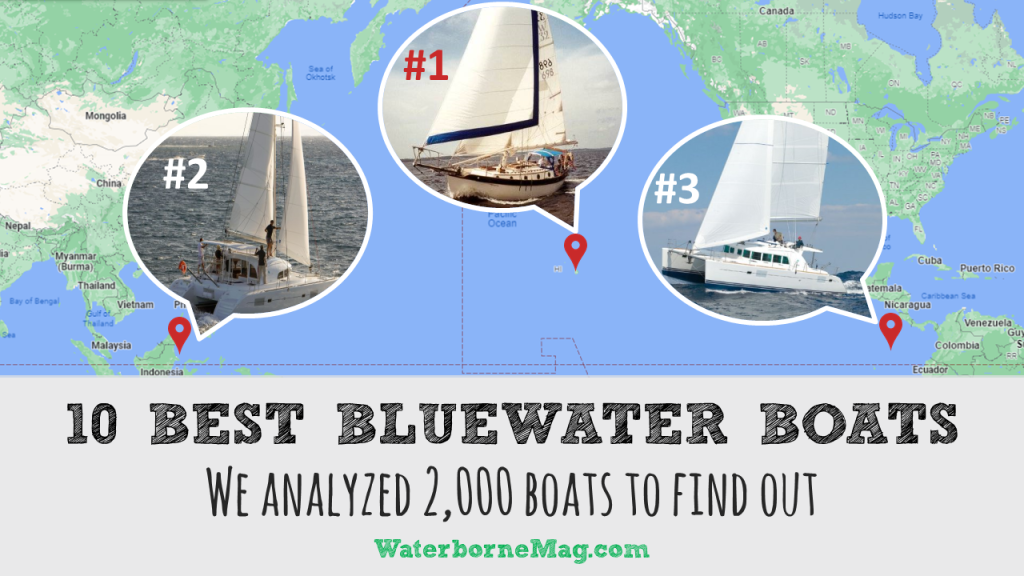
What are the best bluewater sailboats?
This was a question we asked a lot of experienced cruisers when we decided to sail across the Pacific. We needed a boat after all, and we wanted to buy the best bluewater sailboat we could afford.
We heard a lot of strong opinions.
Some sailors thought it was reckless to go offshore in any boat that didn’t have a full keel.
Others prioritized performance, and wouldn’t dream of going anywhere in a slow boat like the Westsail 32 (a.k.a. a “Wet Snail 32”).
Opinions like these left us feeling confused like we had to choose between safety and performance.
If we learned anything from these conversations, it’s that what makes a bluewater boat is a hotly debated topic!
However, there’s a way to cut through all the opinions and get to the bottom of it. The solution is….
We analyzed just under 2,000 boats embarking on ocean crossings (over a 12 year time period) and came up with a list of the ten best bluewater sailboats.
Where did we get our data?
The data for our best bluewater sailboats list comes from 12 years of entries in the Pacific Puddle Jump (PPJ), an annual cross-Pacific rally. We took part in 2017 and had a ball!
You can read about the methodology we used to analyze this data at the bottom of the post.
What do we mean by “best”?
We know, that word is overused on the internet!
Simply, based on our data set, these were the most common makes and models entered in the PPJ cross-Pacific rally. There were at least 10 PPJ rally entries for every make of boat on our top 10 list.
So, these boats are 100% good to go?
No! A bluewater boat isn’t necessarily a seaworthy boat. Almost every cruiser we know made substantial repairs and additions to get their offshore boat ready, adding watermakers , life rafts, solar panels, and more.
Also, you should always have a boat inspected by a professional and accredited marine surveyor before buying it or taking it offshore.
But my bluewater baby boat isn’t on this list!?
There are hundreds of excellent bluewater yachts that are not on this list. For instance, we sailed across the Pacific in a Dufour 35, which didn’t even come close to making our top 10 list.
Choosing the right boat is very much an individual journey.
Where can I find these bluewater boats for sale?
We recognize that a top 10 list won’t get you very far if you’re shopping for a bluewater boat (especially if you’re looking in the used market).
So, to help you find your perfect boat, we’re going to create a big list of bluewater boats that you can use to refine your search on Yachtworld, Craigslist, or any other places to buy a used boat .
Sign up for our newsletter to get our big list of bluewater boats list as soon as it comes out.
We’re also working on a series of posts by size class. For example, if you’re looking for a smaller boat, you can narrow it down to the best bluewater sailboats under 40 feet .
Takeaways from our analysis
There were no big surprises on an individual boat level. All of these makes are considered good cruisers, some of them are even best-selling designs! However, there were a few things that caught our eye.
“Go simple, go small, go now” still holds water
We were thrilled to see the smallest boat in our roundup at the very top of the list! Westsail 32 owners can take pride in their small but mighty yachts (and ignore all those snail-sayers).
While undoubtedly there’s been a trend towards bigger bluewater cruisers in recent years, small cruising sailboats seem to be holding their own. 60% of the monohulls on this list were under 40 feet (if you count the Valiant 40 which sneaks just under at 39.92 feet).
Cat got our tongue
So, we knew catamarans were a thing, but we didn’t fully appreciate HOW popular they’d become!
50% of our top 10 bluewater boat list consists of catamarans—a good fact to toss out the next time you’re trying to garner a happy hour invite on the party boat next door (which will undoubtedly be a catamaran).
Still got it!
We’ve got good news for all you good old boat lovers! 60% of the boats on our list were first built before 2000.
While these older models are less performance-oriented than modern designs, cruisers value these boats for their ability to stand up to rough seas and heavy weather. It just goes to show that solid bones and classic looks never go out of style.
Alright, without further ado, let’s dive into our list of the 10 best bluewater boats!
The 10 best bluewater boats
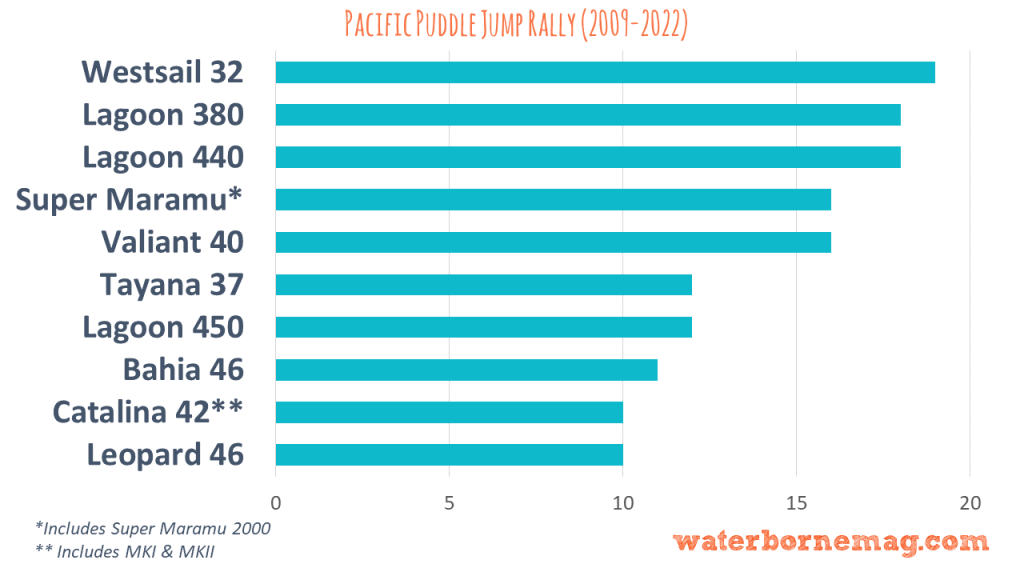
1. Westsail 32
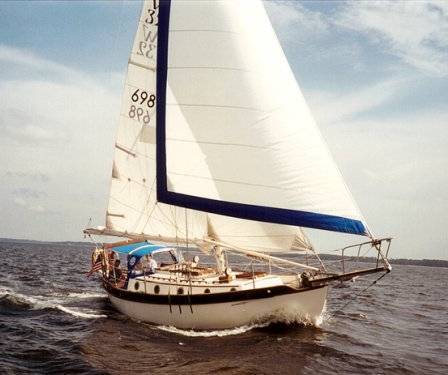
The Westsail 32 is one of the most iconic bluewater cruisers and 19 have set out to cross the Pacific in the PPJ rally since 2009.
In 1973, this small cruising sailboat garnered a 4-page spread in Time magazine. The article inspired many Americans to set sail and the Westsail 32, with its double-ender design, set the standard for what a real bluewater cruiser should look like.
There were approximately 830 built between 1971 and 1980.
This small boat has taken sailors on ocean crossings and circumnavigations. Though considered “slow” by some, the heavily-built Westsail 32 has developed a loyal following for her other excellent offshore cruising characteristics.
If you’re interested in small bluewater sailboats, check out our post on the best small sailboats for sailing around the world .
2. Lagoon 380
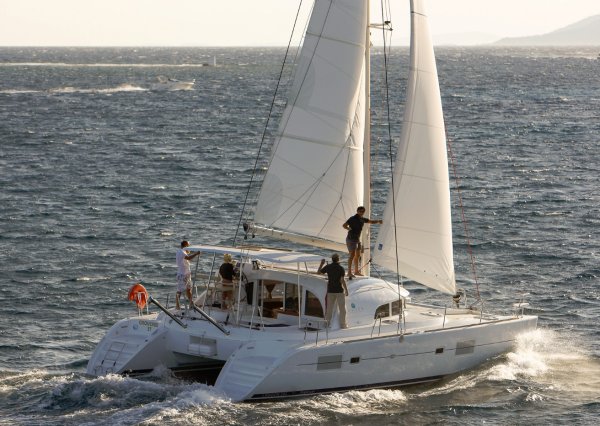
The Lagoon 380 is a reliable, solidly built catamaran and considered roomy for its size. We counted 18 of them in our data set. With over 800 boats built , it may be one of the best-selling catamarans in the world. Like the other boats on this list, the Lagoon 380 has proven itself on long passages and ocean crossings, winning it many loyal fans.
3. Lagoon 440
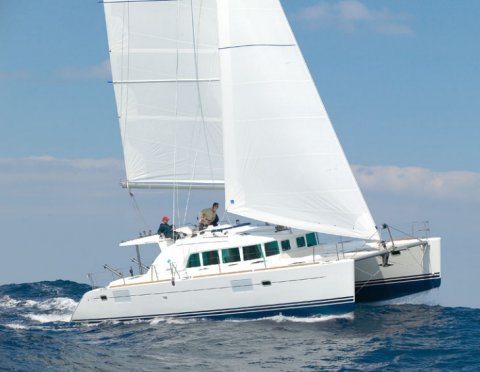
18 Lagoon 440s have set out to cross the Pacific in the PPJ rally since 2009.
Why leave the comforts of home, when you can take them with you? The Lagoon 440 is a luxurious long-range cruiser, offering beautiful wood joinery, spacious accommodations, and a deluxe galley. Oh, and you have the option of an electric boat motor !
SAIL and Sailing Magazine have both done in-depth reviews of the Lagoon 440 if you want to learn more.
4. Amel Super Maramu (incl. SM 2000)
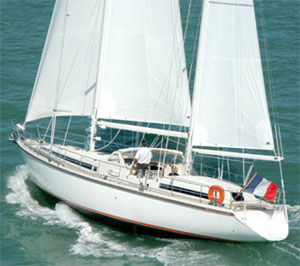
If you follow the adventures of SV Delos on YouTube, you probably know that the star of the show (SV Delos— in case the title didn’t give it away ) is an Amel Super Maramu. These classic bluewater sailboats can be found all over the world, proof they can go the distance.
We counted 16 Amel Super Maramus and Super Maramu 2000s in our list of PPJ entries.
Ready to join the cult of Amel? Read more about the iconic brand in Yachting World.
5. Valiant 40
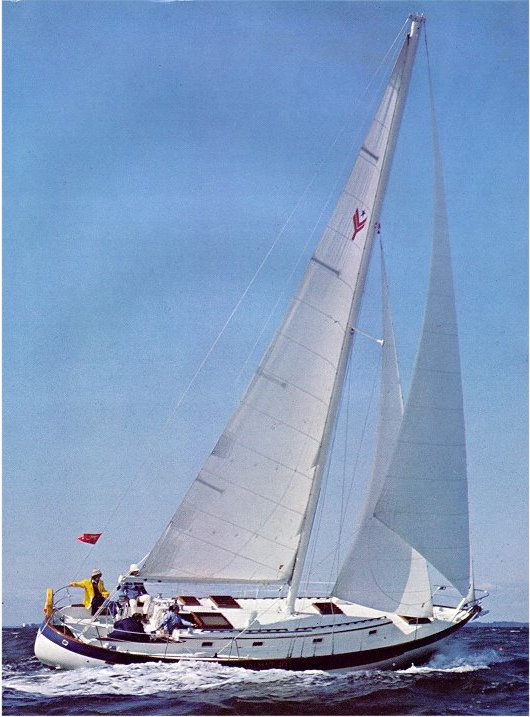
When I interviewed legendary yacht designer, Bob Perry, for Good Old Boat in 2019, he told me that the Valiant 40 was one of the boats that most defined him and marked the real start of his career.
At the time, heavy displacement cruisers were considered sluggish and slow, especially in light winds.
Perry’s innovation with the Valiant 40 was to combine a classic double ender above the waterline, with an IOR racing hull shape below the waterline. The result was the first “performance cruiser”, a blockbuster hit, with over 200 boats built in the 1970s.
It’s no surprise we counted 16 Valiant 40s in our data set.
Cruising World magazine dubbed it “a fast, comfortable, and safe cruising yacht,” and there’s no doubt it’s covered some serious nautical miles.
It’s worth noting that there were blistering problems with hull numbers 120-249 (boats built between 1976 and 1981). Later models did not have this problem. Despite the blistering issues, the Valiant 40 remains one of the most highly thought of bluewater designs.
6. TAYANA 37
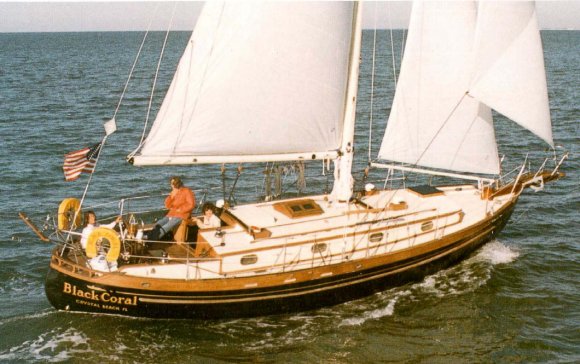
The Tayana 37 is another hugely popular Perry design. The first boat rolled off the production line in 1976 and since then, nearly 600 boats have been built. Beautiful classic lines and a proven track record have won the Tayana 37 a devoted following of offshore enthusiasts.
12 Tayana 37s have set out to cross the Pacific in the PPJ rally since 2009. Read more about the Tayana 37 in this Practical Sailor review .
7. Lagoon 450
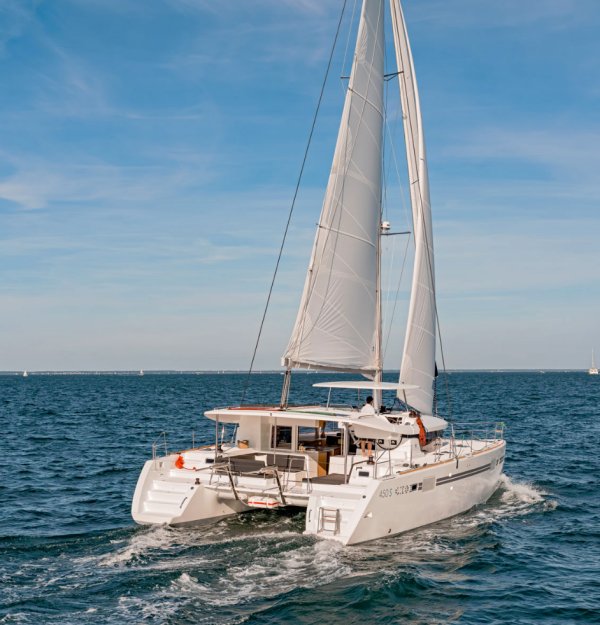
If this list is starting to sound like a paid advertisement, I swear we’re not on Lagoon’s payroll! This is the third Lagoon on our list, but the data doesn’t lie. Lagoon is making some of the best cruising sailboats.
The 450 has been a hot seller for Lagoon, with over 800 built since its launch in 2014. While not a performance cat, the Lagoon 450 travels at a reasonable speed and is brimming with luxury amenities.
At least 12 owners in the PPJ rally chose the Lagoon 450 to take them across the Pacific. It’s no wonder SAIL had so many good things to say about it.

8. Fountaine Pajot Bahia 46
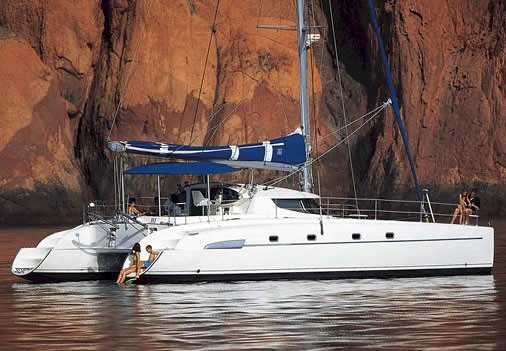
There were 11 Fountaine Pajot Bahia 46s in our data set.
Fountaine Pajot released the Bahia 46 in 1997, a sleek design for traveling long distances. Its generously-sized water and fuel tanks along with ample storage for cruising gear are a real plus for the self-sufficient sailor.
According to Cruising World , “Cruising-cat aficionados should put the Bahia 46 on their “must-see” list.”
9. Catalina 42 (MKI, MKII)
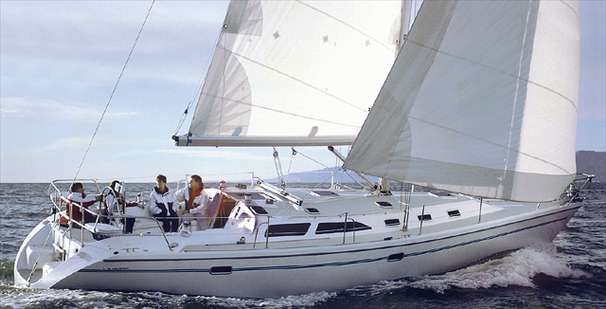
10 Catalina 42s (MKI and MKII) have set out to cross the Pacific in the PPJ rally since 2009.
The Catalina 42 was designed under the guidance of the legendary yacht designer and Catalina’s chief engineer, Gerry Douglas.
One of Catalina’s philosophies is to offer “as much boat for the money as possible,” and the Catalina 42 is no exception. According to Practical Sailor , Catalina aims to price its boats 15% to 20% below major production boats like Hunter and Beneteau.
Practical Sailor has a great in-depth review of the Catalina 42 .
10. Leopard 46
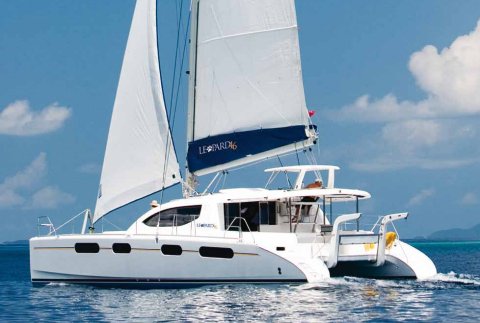
Since 2009, 10 Leopard 46s have embarked on Pacific crossings in the PPJ rally.
Leopards have won legions of fans for their high build quality, robust engineering, and excellent performance.
The Leopard 46 also boasts something of a racing pedigree. It was built in South Africa by Robertson and Caine and designed by Gino Morelli and Pete Melvin, who came up with the record-breaking catamaran Playstation / Cheyenne 125 .
Read more about the Leopard 46 in this Cruising World review .
Methodology
What the data is and isn’t.
The PPJ data was a real boon because it reflects a wide range of cruising boats: small, big, old, new, expensive, and affordable. We think this may be because the PPJ is a very financially accessible rally—the standard entry cost is $125 or $100 if you’re under 35 (age or boat length!).
We did look at data from other (pricier) rallies but found that the results skewed towards more expensive boats.
Needless to say, the data we used is just a sample of the bluewater boats that crossed the Pacific over the last 10+ years. Many cruisers cross oceans without participating in a rally!
Entries vs. completions
The data we used is a list of the PPJ entries, not necessarily the boats that completed the rally. In instances where we saw the same boat entered multiple years in a row, we assumed they’d postponed their crossing and deleted all but the latest entry to avoid double counting.
Boat make variations
The world of boat building and naming can get pretty complicated. Sometimes a manufacturer changes a boat’s name a year or two into production, other times the name remains the same but the boat undergoes a dramatic update.
For the most part, we’ve used SailboatData.com’s classification system (if they list the boats separately, then we have also), except where there are two separately listed models that have the same LOA, beam, and displacement.
Fiona McGlynn is an award-winning boating writer who created Waterborne as a place to learn about living aboard and traveling the world by sailboat. She has written for boating magazines including BoatUS, SAIL, Cruising World, and Good Old Boat. She’s also a contributing editor at Good Old Boat and BoatUS Magazine. In 2017, Fiona and her husband completed a 3-year, 13,000-mile voyage from Vancouver to Mexico to Australia on their 35-foot sailboat.
Terms and Conditions - Privacy Policy

What Is a Blue Water Catamaran? (Pictures and Examples)
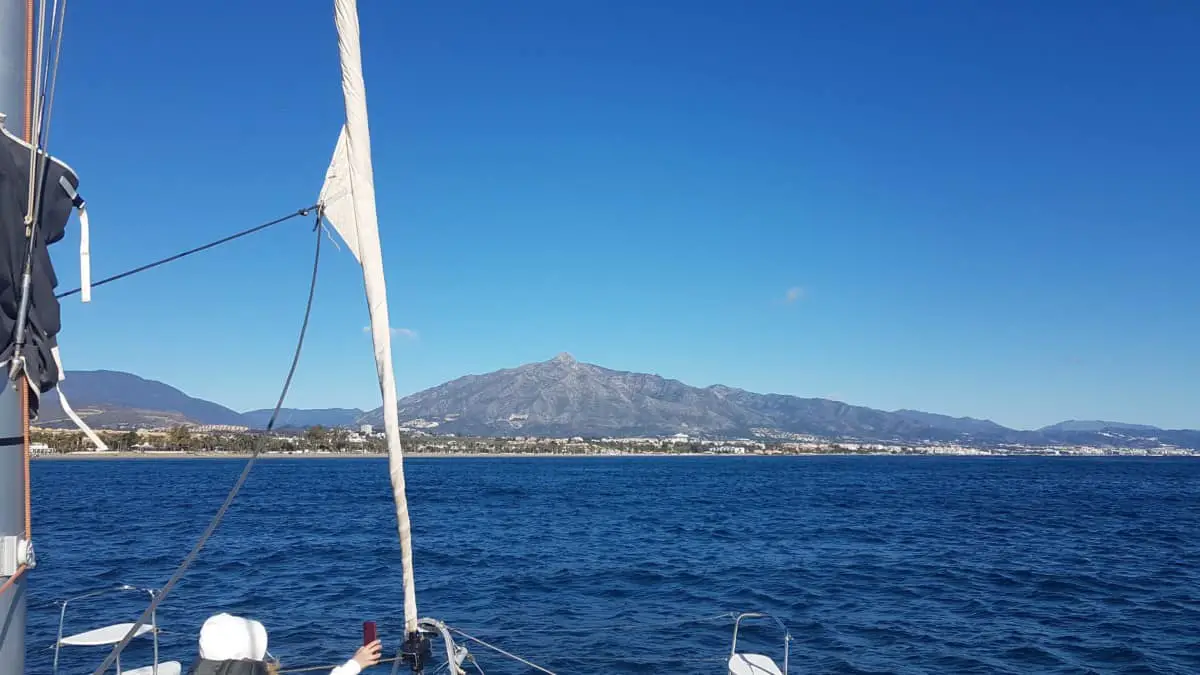
As an Amazon Associate, we earn from qualifying purchases. We may also earn commissions if you purchase products from other retailers after clicking on a link from our site.
When I transitioned to a life of seaborne travel and adventure, it came with several challenges, the first being deciding the type of boat to use. In that process, I came across terms like “blue water sailing” and “catamaran.” A few years later, I think I got the hang of it, and today I want to share my knowledge on what exactly a blue water catamaran is!
A bluewater catamaran is a multi-hulled vessel used for extended voyaging that can sail in very rough seas. Offshore catamarans are usually 40ft or longer, very stable, carry heavy loads, and are designed to be very safe.
Some say blue water catamarans make sailing under the most demanding conditions comfortable and safe, but are they right? Read on for detailed explanations of the features that make this boat type an excellent choice for sailors.
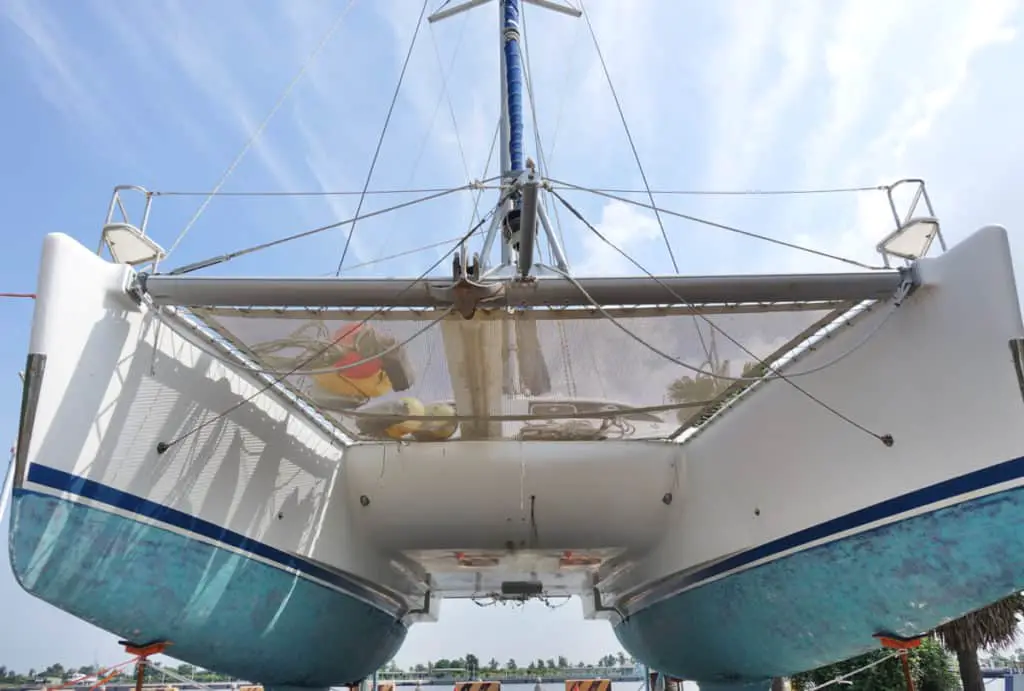
Table of Contents
What Is a Catamaran?
A catamaran is a sea vessel constructed from two hulls that lie perpendicular to each other. This type of boat is traditionally used for recreational purposes. However, it is also quite common to use them in the commercial fishing industry.
If you want an in-depth explanation i suggest you read this article.
They are fitted with both sails and a combustion engine, these can run together or separately.
Usually, these vessels will have at least one headsail (generally referred to as a staysail), and one mainsail.

What Is a Blue Water Catamaran?
Bluewater catamarans are generally larger than boats made for coastal sailing. On average, these vessels come in sizes between 30 – 70 ft, offering cargo and passenger space for a few dozen people or more. They feature carbon fiber or fiberglass construction and come in different sizes for various activities. Some of these blue water boats feature flybridges.
What is a flybridge?
A blue water boat is a boat that is optimized for sailing big oceans and doing long ocean passages. This is to be compared to a coastal cruiser which mainly is used for sailing less rough waters and where the need for storage to hold multiday provisions isn’t necessary. A bluewater catamaran is also equipped with more advanced technology and offers better protection from the weather. More on this further down in the article.
Why Are They Called Blue Water Cats?
Blue water sailing is a term that refers to the open ocean. Non-blue water sailing, on the other hand, typically means navigating inland waterways and coastal areas.
The difference between blue and non-blue waters lies within their visibility as well as hazards present in each location. The two types of seas have different types of challenges for sailors, especially when it comes to navigation at night or if you have a storm brewing on the horizon.
Blue water sailing is primarily done on the open seas where there is a lot of room to maneuver and travel long distances without hitting land or running into shallow waters. These types of voyages take place during the day, as well as at night when necessary. As a result, blue water sailing requires more gear, skills, and sturdier vessels.
Non-blue water sailing typically does not venture out too far from shore and stays within sight of land so that it is possible to find a way back home if need be.
Generally, blue water boats are more powerful (bigger sails and engines), while non-blue water vessels may not need to move at higher speeds, so they feature smaller sails and engines with lower horsepower.
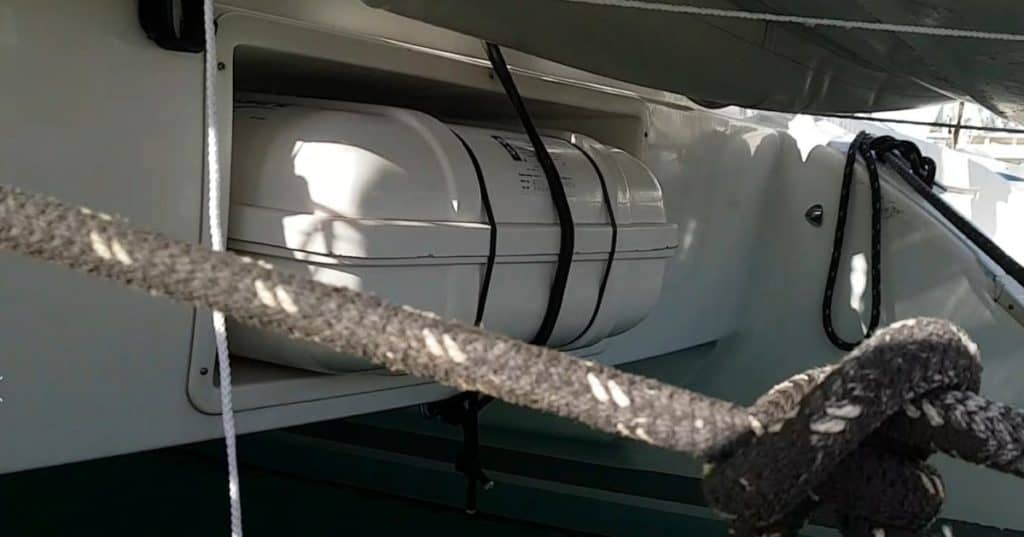
How Is a Blue Water Catamaran Equipped?
A blue water catamaran comes with all the equipment necessary to make your voyage on open water safe and as comfortable as can be.
Here are some of the standard features you’ll find in this boat type:
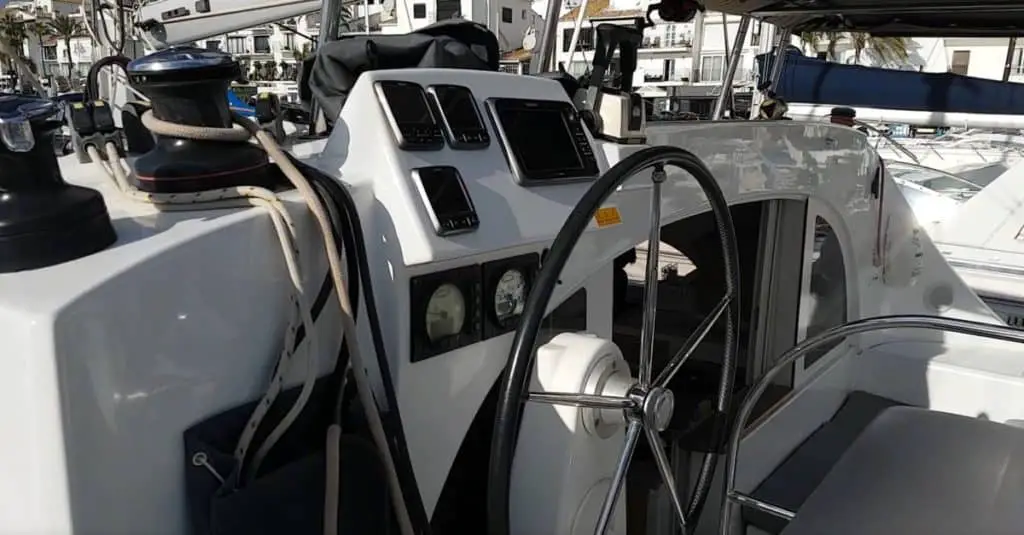
The autopilot is a critical component of a blue water boat. Cruising without it can arguably be an absolute nightmare. You’d be precisely glued to the helm the entire journey, making it burdensome and uncomfortable. These boats come with in-board pilots whose rams are fixed directly to their rudder segments.
This is not a “nice” to have feature; it is definitely a “need,” Without it, you will tire out the crew and significantly increase the risk of sailor error.
The best catamarans feature durable, easy-to-adjust, and effective pilots that can easily take you on a voyage without breaking down.
Pro tip: carry one extra, sooner or later it will break!
Global Positioning System (GPS)
The GPS is undoubtedly essential equipment on any cruising vessel. Blue water boats come with either bottom of the range GPS, which gives you the exact position, or top of the range GPS, linked with electronic cartography.
Electronic cartography allows you to view charts for the whole world, the boat’s position, speed, waypoints, ETA, water depth — to mention but a few — resulting in a much more effortless navigation. For instance, you can use it to avoid rocks when sailing along a coast.
There are many options but usually it is the budget that sets the standard.
A Good Dinghy
A good dinghy is a must-have in a catamaran. You use it to go ashore, bring provisions into the boat, refill water, go diving, or lay an anchor to complete your mooring – it’s a versatile piece of equipment that makes cruising easier.
It can be placed at the stern, or under the davits, between the hulls to allow for flexibility and easy access to hard-to-reach places, such as coral beaches.
Remember! A dinghy is not a life raft, they are designed for different things!
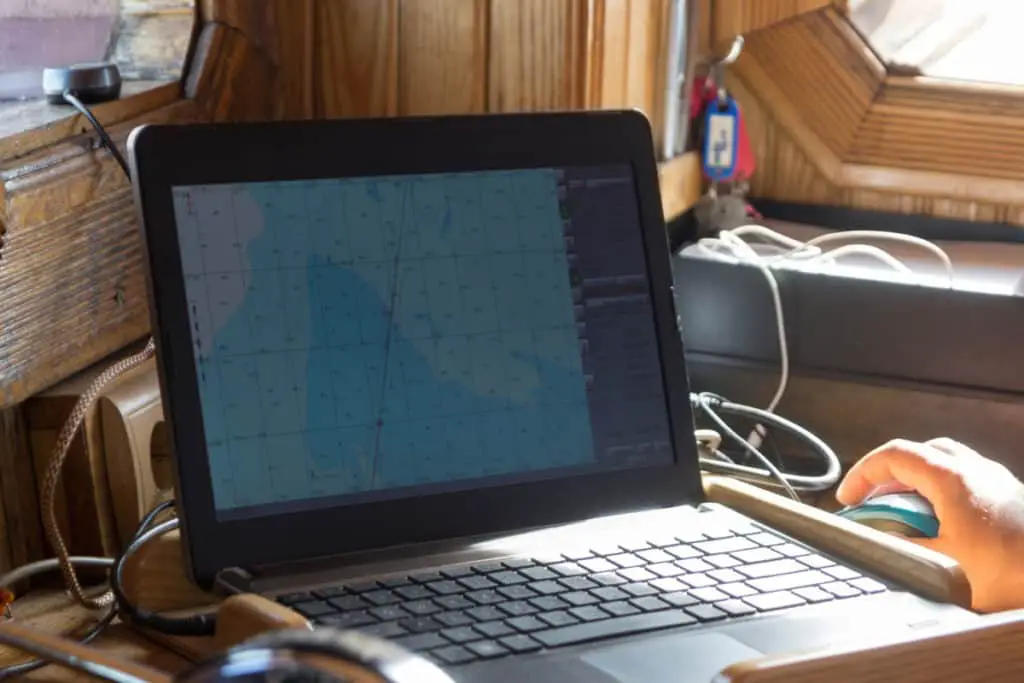
Computer/Navstation
Modern cats come with computers for comfort, convenience, and safety. These devices are used for electronic cartography, receiving weather data, and as support for the logbook.
You can use them to process digital photos and send or receive emails – you can still keep in touch with clients and friends as you enjoy the therapeutic sea. Besides, you can store music and watch movies during the journey – the applications are endless!
A marine radar scanner is a critical offshore device and a must-have on a blue water catamaran. It’s used to detect obstacles, other sea vessels, to mention but a few. It produces radio waves, which travel around the water surrounding the boat up to the horizon. It then detects if the waves have been reflected, showing you whether there’s an object on your course. This information is essential since you need it to avoid a collision.
It will also show you where the closest squall is and what direction it is headin giving you enough time to reef your sails.
Power Source
A catamaran’s engine and appliances must be supplied with energy – a no-brainer. A cat generally comes with two starter batteries: one for each engine and one or two more for its equipment. These batteries are charged by the engines. However, you must run the engine for several hours daily to keep them charged.
Instead of that, most sailors use solar panels or wind generators. A technology that is becoming more and more common is using the propeller to generate energy.
Many cruisers also have a standalone generator for charging batteries and supplying power to on board electronics.
What To Look For in a Blue Water Catamaran
When buying a cat, it’s critical to identify the one that best suits your needs. Regardless of whether you plan to use it for fishing, racing, or voyaging, here are some of the critical factors you should consider:
The key considerations here should be strength and durability. Fiberglass is generally the main material type used in hull construction. Fiberglass is the most preferred since it’s strong and durable. The difference lies in the hull core, usually the core is either some organic material such as balsa, or it could be a synthetic such as plastic foam.
The balsa is cheap, but if there is a water intrusion, it will start to rot, and structural integrity may suffer. The foam sandwich type is usually unaffected by water intrusion but tends to be more expensive.
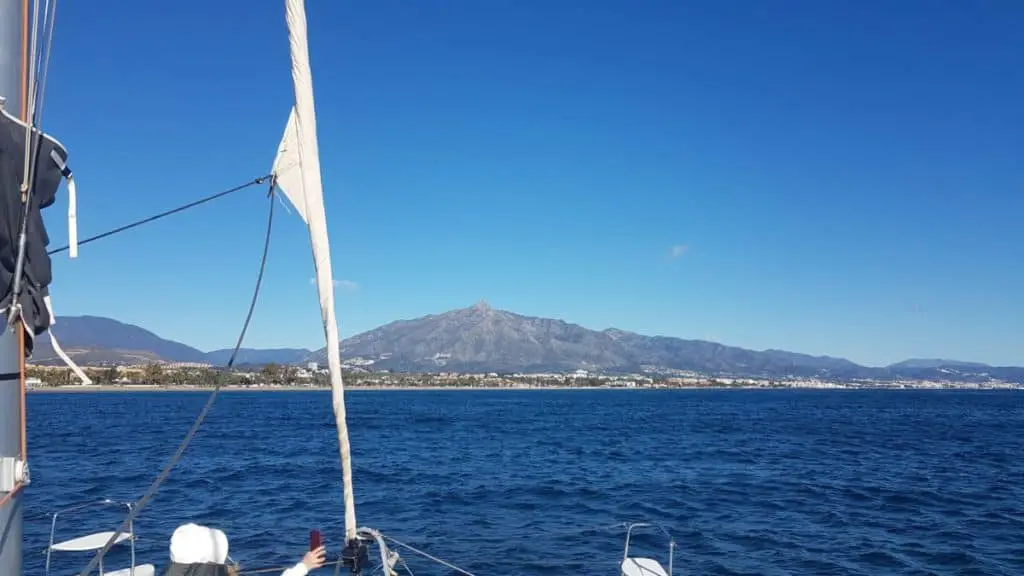
The Sailplane
It would be better to pick a catamaran with an easy-to-handle sailplane. The primary issue here is manageability – the staysail should be easy to replace using a hanked-on storm jib during stormy weather. Also, even though you have a crew on board, the sails should be set up for shorthanded sailing, so the helmsman doesn’t have to wake up the crew every time adjustments need to be made.
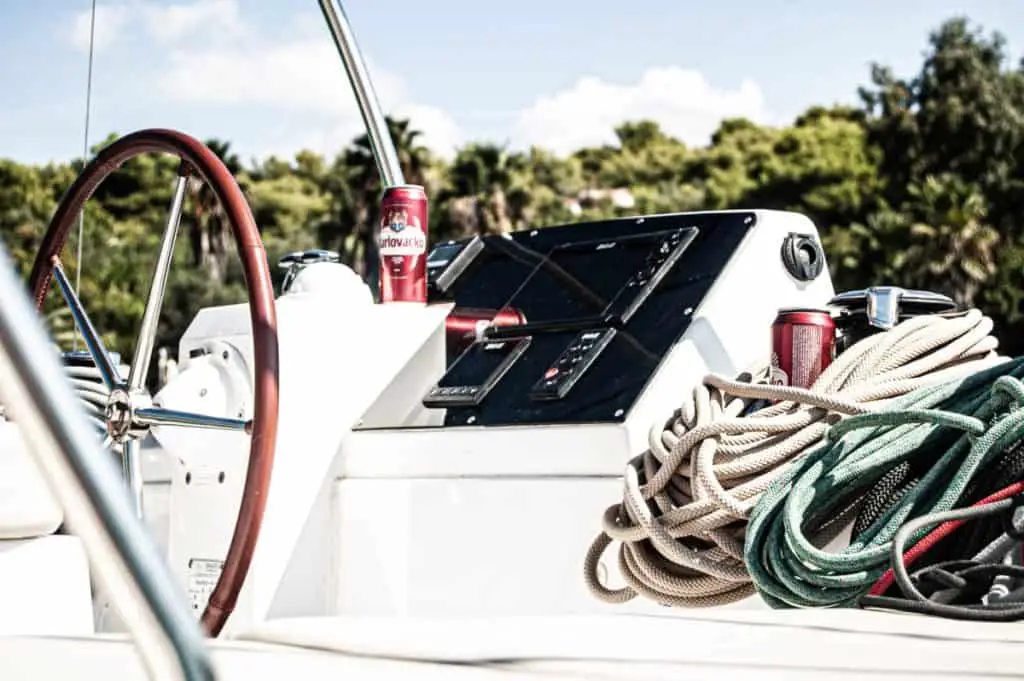
The cockpit should be a priority consideration when choosing a catamaran for offshore adventure.
Aft cockpits are generally better than center since they’re lower and better protected, making them safer. Besides, an aft and centered cockpit suffer less impact from boat motion.
Flybridge helms are great looking and awesome for coastal sailing, but for safe offshore passages, they offer many safety issues that, if you want to, can read all about in another one of my articles .
Heavy or Light Displacement
The opinions of sailors on the displacement type vary based on the tradeoffs of either option. On the one hand, a heavy displacement hull with long overhangs and a full keel provides a more comfortable ride in rougher conditions but performs poorly in lighter conditions.
On the other hand, light displacement is limited in stowage. Most notably, too much load affects its displacement ratio, compromising performance. However, it comes in handy when you need to manage heavy going.
When talking about catamarans one should mention that “heavy displacement on a cat” is not the same as “heavy displacement on a monohull”. The cat will still be very light in comparison to the monohull, but when comparing a catamaran with another catamaran “heavy” vs “light” makes sense.
Water Supply
During your journey, you’ll definitely need sufficient fresh water for washing, cooking, and drinking. Because of that, you should look for the water storage capacity of your sailboat.
As a rule of thumb, you should look for a cat with sufficient water storage for your crew, plus a 20% allowance. To put it into context, a couple on a transatlantic passage would need two imperial gallons daily, plus a 20% contingency allowance.
Suppose the couple goes on a three-week adventure. In that case, they’ll need a minimum of 50 gallons of fresh water. Blue water cats ideally have double that capacity, usually split into two tanks. If one gets contaminated, they can use the second one.
Tip: It’s prudent to rig a system that catches rainwater when the boat is underway or anchored. You can also use a reverse osmosis watermaker. However, it shouldn’t be the sole source of water. These watermakers can break down, causing a lot of inconveniences.
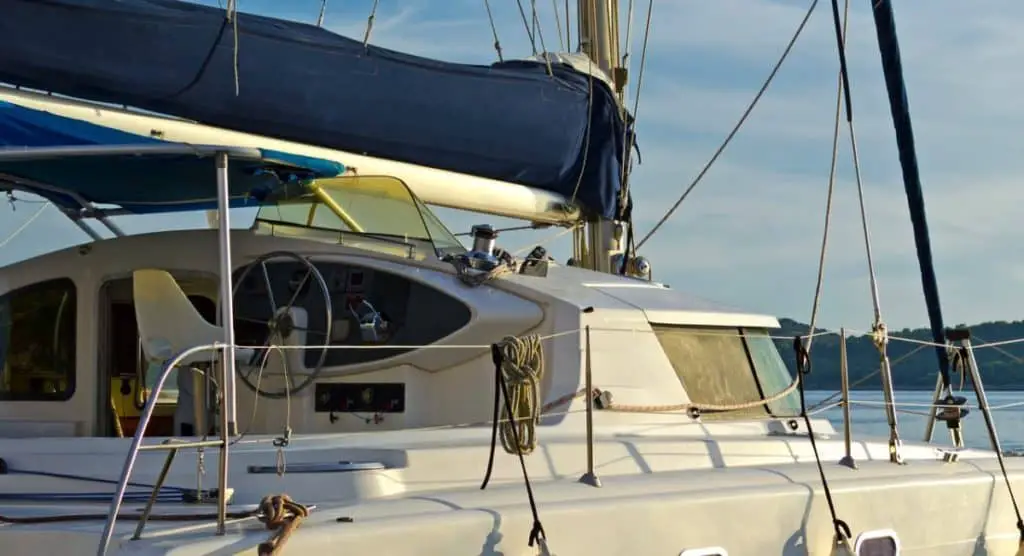
Protection From the Elements
However much you may wish to cruise in sunny, calm, dry weather to have an uninterrupted view of marine life during your journey, chances are you’ll encounter some rain, wind, or flying spray. Therefore, it’s better to pick a catamaran that comes with a well-protected helm to shelter you and your crew from the elements. Depending on your preference, the dodger can be a canvas construction around a collapsible frame or a rigid structure.
Too much sun can also cause discomfort and damage your skin, so you should ensure the sailboat comes with a bimini top cover.
What Are the Best Blue Water Catamarans?
There are so many awesome blue water catamarans I could make an entire website about them, but here I have listed two interesting examples that could act as a jumping-off point to your future research.
The Lagoon 55 is a luxurious cat designed by Marc Van Peteghem , a renowned French Naval architect. This boat is spacious – it can be arranged with up to six double cabins and comes with a more extensive flybridge. Its transom’s surfaces aren’t just a way to access this vessel; they can be converted to a living area. This boat also comes with a dedicated forward cockpit connected to the saloon by a drop-down window.
Fountaine Pajot Elba 45
The Elba 45 is an incredible catamaran. Designed to replace the Helia 44, this boat has done the job perfectly. It comes with high-speed, efficient motoring, and remarkable performance. Its fixed stub keels and aft-raked bows deliver top-notch windward performance.
To improve safety, this sailboat’s keels are glued into a designed recess in the hulls. Because of that, none of the keel bolts can rip out and put you in danger in the event the Elba 45 gets grounded or collides with an obstacle.
Besides, this boat features a low-profile lounging space, a pronounced reverse sheer that minimizes the bulk of windows to create useful space below, and high topsides and bows.
If these are out of your range or not interesting I suggest you check out some of my other articles:
- Best catamarans under $200k
- Best catamarans under $100k
- Best catamarans under 50ft
- Best catamarans under 30ft
- Best catamarans for couples
- Best catamarans sailing around the world
Frequently Asked Questions On Blue Water Cats
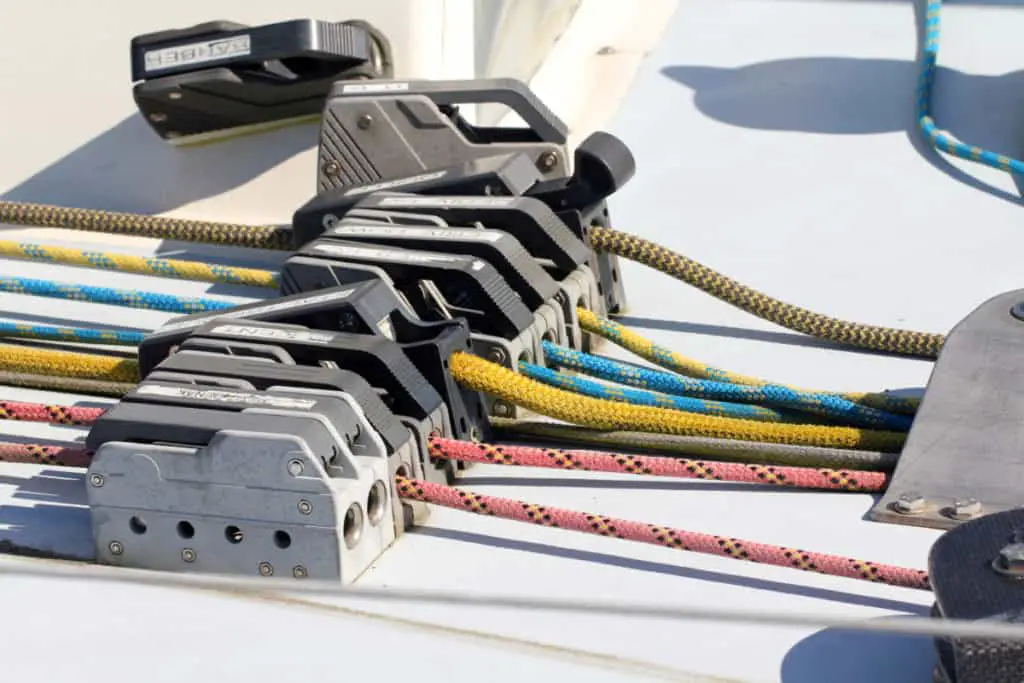
Can One Person Solo a Blue Water Catamaran?
Blue water cats (and cats in general) can be sailed shorthanded if they are set up correctly, this setup includes all lines to the cockpit, roller furling mainsail, and autopilot. The skill of the sailor is also essential for safe single-handed sailing.
Tip: Take extra precautions when sailing offshore such as adding an emergency position indicating radio beacon (EPIRB) or including additional radar reflectors on board.
Also, before sailing a blue water cat, check the relevant state and federal regulations. For instance, most states require sailors to complete safety courses before sailing, while others require you to obtain a license.
I have a dream of solo sailing my cat around the world, if you want to know how this can be done I suggest you read some of my other articles:
- Can one person sail a catamaran?
- Best solo blue water catamarans
- How to single-handed sail a cat
Can I Cross Oceans Using a Blue Water Catamaran?
Crossing an ocean with a blue water catamaran is one of the safest ways to do it! This is due to their excellent stability, safety, and crew space on board. They are inherently more stable than any other type of boat due to their exceptional buoyancy and roll inertia from their unique hull design.
This means that these catamarans will seldom capsize in extreme conditions but give good protection against the weather or damage caused by strong wind gusts. They also have less side motion, so even though waves may break over the deck during bad weather, there’s no risk of people sliding off, creating a man-over-board situation.
What Is a Good Size Catamaran For Crossing Oceans?
The perfect sized catamaran for sailing big oceans is around 40ft; it is small enough to be sailed by one person but big enough to provide safety and speed. Of course, there are many variables to consider.
Want to know more? Read Best sized Catamaran for Ocean Sailing and Liveaboard
Wrapping Up
Indeed, a blue water catamaran is the best companion for anyone going on a long adventure on the sea. Its fiberglass construction, twin hulls, expansive deck and interior space, and natural redundancy design makes for a safe advenure.
I hope this was useful, take care and live the adventure!
Owner of CatamaranFreedom.com. A minimalist that has lived in a caravan in Sweden, 35ft Monohull in the Bahamas, and right now in his self-built Van. He just started the next adventure, to circumnavigate the world on a Catamaran!
Leave a Reply Cancel reply
Your email address will not be published. Required fields are marked *
Save my name and email in this browser for the next time I comment.
Recent Posts
Must-Have Boat Gear for Catamaran Sailors!
Sailing is probably the most gear-intensive activity I've ever done; there are so many decisions to be made about what gear to buy now, for tomorrow, and what to definitely never buy. The gear on...
6 Best Trailerable Trimarans For Bluewater and Coastal Sailing
Having a boat costs a lot of money, even when you are not using it, marina fees, etc. And once it is in the water most sailors never go very far from their "home marina" and sailing will be somewhat...
Yachting Monthly
- Digital edition

Monohull or multihull: which is best for blue water?
- Chris Beeson
- March 29, 2016
As former editor of Yachting World, David Glenn has plenty of experience of both monohull and multihull cruising. Here he weighs up the pros and cons

One hull, or two? Your choice will define your life afloat Credit: David Glenn
Through the binoculars I could see masts off Basil’s Bar on Mustique. Their lack of movement suggested a fine anchorage, sheltered from the tradewind-driven swell that builds up in the channel between Mustique and Bequia. It soon became apparent that most belonged to cats, immune from the rolling monohulls like ours would endure if we were to stop in this otherwise enticing bay.
More anchorages in a multi

Cats galore off the Soggy Dollar Bar, Jost van Dyke: too shallow for a fixed keel monohull of similar size
Stability is one of the truly great advantages of a cruising multihull. Not just at sea where the tiresome business of heeling is something that simply doesn’t – or shouldn’t – happen to any great extent, but at anchor too. It dramatically widens one’s choice of anchorages to include those affected by swell – not uncommon in the Caribbean, for instance, where a subtle change in wind direction can make a previously flat calm anchorage unbearable in a monohull. Its comparatively shoal draught widens the choice still further.
I grew up with monohulls, own one, and frankly wouldn’t consider a multihull for the sort of sailing I do. In northern European waters, marina berthing is a regular necessity and completely safe open anchorages are few and far between.

No rolling or heeling, 360° views and one-level living, as here on a Lagoon 52, appeal to many
But if I were to undertake some serious blue water cruising and I wanted family and friends genuinely to enjoy being afloat, particularly those less experienced, a multihull would have to be a consideration. I would have to put aside the question of aesthetics – let’s face it, they’re ugly beasts – and forego that unique and satisfying sensation of a yacht sailing well, because to date I have not experienced it in a cruising multihull. And that’s quite a sacrifice.
More space in a multi
My attitude changed after chartering catamarans in the Caribbean and Mediterranean. The need to accommodate two families comprising largely of teenage children made the choice of a multihull a no-brainer. In a 46-footer we could accommodate a party of 10 in comfort and the paraphernalia demanded by youth, like surfboards, windsurfers, kites and snorkelling kit, without feeling jammed in.

One-level living makes a big difference when sailing as a famly
The cavernous berths in the ends of the hulls, the wide saloon-cum-galley with its panoramic view and the inside/outside lifestyle made possible by the juxtaposition of the big aft deck and the same level saloon, got the entire crew onside instantly.
As an outside living space, with a trampoline at one end and a massive aft deck at the other, there is simply no comparison with a monohull of the same length. So space, linked to stability, makes for an experience that everyone, even the timid and novices, will find hard not to enjoy.
No speed difference

A multihull, like this Moorings 46, has abundant stowage on deck and below, but filling it all will slow her down
Load-carrying ability is a double-edged sword. On the up side there is room for a big crew and its kit, much more fresh water tankage than a monohull, eliminating the need for an expensive, temperamental watermaker, and finding space for a generator should be easy.
On the down side the temptation to overload will probably cancel out any perceived performance advantage. Multihulls can be relatively quick in the right offwind conditions, but if they are heavily laden – as they will be for blue water cruising – there really is no significant speed advantage.

The Gunboat 66 Phaedo 1 piles on the speed, but for blue water cruisers, comfort and stowage is more important than pace
Some new designs such as Gunboat and Outremer have concentrated on performance, but most clients aren’t overly concerned about outright speed and are happy to trade performance for the considerable comfort offered by brands like Lagoon, Broadblue, the Fontaine Pajot stable, Leopard, Catana, Privilege and others.
Mono sails better

Monohulls, like this Amel 55, sail better upwind, and her ballast keel adds displacement, which means comfort when it’s rough. Multihulls can develop an unpleasant motion in a big sea
Upwind, most cruising multihulls won’t point like a monohull with a deeper keel, and when it gets lumpy and fresh, the motion can become distinctly unpleasant. You have to keep a particularly careful eye on sail area too, but more of that in a moment.
In 2011 I was involved in a test of three cruising catamarans and among my fellow judges was multihull design legend Nigel Irens. He pointed out that catamaran buyers have voted for accommodation (which means weight) over performance, so the dilemma of mixing the two has largely disappeared. With it went the spectre of capsize because, relative to their displacement and beam, the modern cruising catamaran is under-canvassed. But that doesn’t mean that sailors can simply set sail and go in any weather.
‘Speed limits’ on a multi

On a multihull, it’s more important to know when to reef. Set speed limits and stick to them
Also on the panel was Brian Thompson, the lone Brit on board the 130ft French trimaran Banque Populaire V that sailed around the world in under 46 days. He told me that the tell-tale signs for knowing when to reef are far more subtle on a multihull. Apart from instinct, Brian suggested monitoring boat speed closely and having a speed limit to trigger reefing. It is easy to overlook a building breeze when bowling along downwind in a multihull, which is going faster and faster. ‘Keep your boat speed within safe limits you should not get into too much trouble,’ he said.
People often ask about anchoring a multihull, which is important as a multihull will spend a lot of time at anchor. Squeezing into a marina can be nigh on impossible, and expensive if you can get in. An essential piece of kit, which should be standard with a new boat, is a bridle that runs from either hull and keeps the anchor cable on the centreline. In many ways this is easier than anchoring a monohull as it prevents the ground tackle from fouling the hulls.
If you do get alongside a marina pontoon you will soon discover another modern cruising multihull issue: excessive freeboard. It’s worth investing in a portable ladder for those marina moments. Of more concern is MOB recovery. There are bathing platforms on both hulls of most new boats, but it’s not the place to be if a yacht is pitching in a heavy sea. So considerable thought needs to be applied to retrieving an MOB if the worst happens.
The recent and dramatic increase in numbers of multihulls going blue water cruising is certainly testament to their appealing ‘lifestyle’ attributes, but one must bear in mind that they are not a fix for all liveaboard cruising challenges. It’s just a different way of doing things. The elements remain the same and can inflict just as much punishment for the unwary on a multihull as they can on a monohull.
Enjoyed reading this?
A subscription to Yachting Monthly magazine costs around 40% less than the cover price .
Print and digital editions are available through Magazines Direct – where you can also find the latest deals .
YM is packed with information to help you get the most from your time on the water.
- Take your seamanship to the next level with tips, advice and skills from our experts
- Impartial in-depth reviews of the latest yachts and equipment
- Cruising guides to help you reach those dream destinations
Follow us on Facebook , Twitter and Instagram.

Best Single-Handed Bluewater Sailboats

Last Updated by
Daniel Wade
December 28, 2023
Sailing alone in racing or time on the water is a great experience. Finding the best single-handed blue water sailboat for those needs can be a tough task.
Regardless if you have a cruiser or racing sailboat, a single-handed one can offer many opportunities versus larger boats. So what are some of the best ones on the market?
The Hunter Channel 31, J/109, and West Wight Potter 19 are great budget-friendly, single-handed sailboats. Moving up in price, you can look at Hanse 371, Jeanneau Sunfast 3200, and even a Dehler 29. Depending on the size and the amount of features it has will determine what they are worth.
While the budget will play a role in finding the right single-handed boat for you, there are plenty of other factors to consider. These range between comfort, stability, and useful features.
According to experts in sailing, most prefer comfort over price as long as it is justifiable with the amount you are paying. As long as it is not too far over your budget, you could consider a slightly higher-priced boat if it has a few more bells and whistles to make your life easier.
Table of contents
12 Single-Handed Sailboats to Consider
Whether you are planning to cruise around or going out for the day sailing, there are a handful of sailboats to consider. You want to choose one that is best operated alone and would not need additional hands to make it work.
{{boat-info="/boats/rs-sailing-rs-aero"}}
For a fun day out at sea, it is hard to pass up on a quality dinghy . This one, in comparison to other dinghies, is fairly light and takes hardly any time to set up.
The RS Aero is one of the more technologically advanced dinghies for one individual to use. This one in particular has amassed a handful of awards for the best performance overall.
Due to its popularity and quality, these range between $10,000 to $15,000. If you find it any cheaper than that, it could be worth the investment.
2. Beneteau Oceanis 62
{{boat-info="/boats/beneteau-oceanis-yacht-62"}}
If you are feeling a bit adventurous or feel confident in your ability to handle a large boat by yourself, then try out the Beneteau Oceanis 62 . This boat is slightly over 60 feet, so it is recommended that you have all your ducks in a row before setting sail.
Thankfully, the boat was designed with ease of use in mind. So this could easily be operated by one person if they have some experience with it.
If you purchased this one for the family, then you can still have the added benefits of taking people with you. But if you decide you want to be by yourself, that is an option too.
This boat is valued around $600,000, so it is arguably one of the more expensive options for just a single handed sailboat. But if you are looking for a family boat, you are killing two birds with one stone.
3. Hunter Channel 31
{{boat-info="/boats/hunter-channel-31"}}
This British made sailboat debuted in 2001 with a twin keel, making it a great choice for solo sailing. While it has a rich history in racing, the design has gone through slight adjustments over the years to make it a solid cruiser.
With its incredible handling and quick turns, this sailboat has excellent handling. The hull structure allows it to have a low center of gravity and provide it with increased stability compared to other racing boats.
The deck layout, in combination of the self-tacking jib and tiller steering, allow this boat to be one of the best on the market if you can find it.
You can usually sail these fractionally rigged and reef with ease from the cockpit. For around $35,000, you are getting a great deal on a boat that has everything you need.
{{boat-info="/boats/j-boats-j109"}}
If you are not quite ready to venture out alone or want the availability to take people out with you, then the J/109 is a great sailboat to look into. These were first built in 2004, so you should be able to still find them today.
If you decide that you want to take it out by yourself, you could look into going offshore and into areas where other boats have difficulty reaching. You might be able to get it to plane on open water, but it is a little heavy.
With its asymmetric spinnaker, you should be able to jib from the cockpit with light wind. Even in heavier winds, this boat offers great stability.
Due to its high standards of construction and long term stability, these boats are still valued around $60,000. If you can find one a little less for that, it could be a steal.
5. West Wight Potter 19
{{boat-info="/boats/west-wight-potter-19"}}
This boat design has been around since 1979, which prioritized safety and handling. Those factors alone make it a quality solo handling boat.
This sailboat has grown on many over the last three decades. People have probably overlooked it due to its name, but you should definitely check it out if you find one.
The slight design changes over the years have turned this into a tough little boat. It has a Bermuda rigged sloop and can handle various conditions.
With its lifting keel, it allows it to navigate shallow waters. This boat might be one of the more versatile options out there if you plan on sailing in shoal drafts.
For the price, it is hard to beat something less than $10,000. If you are wanting a newer version with upgraded features, you could be spending around $25,000.
6. Hanse 371
{{boat-info="/boats/hanse-371"}}
For a mid-sized cruiser, it will be hard to pass up a Hanse 371 if you come across it. This boat design is geared towards single handed sailing, with a perfect mix of older and newer technology.
It has a furlong and self-tacking jib, along with an autopilot feature making it easy to use for one person. For a boat that was built around 2000, it was well ahead of its time.
Even though the boat is a bit larger than some others for solo sailing, you will have plenty of space to move around. With the large galley and quite a bit of cabin room, you will feel like you are in a mansion.
The look and handle of this boat is favored by many, which is why it still holds its value. You can potentially find ones for sale around $60,000.
7. Jeanneau Sunfast 3200
{{boat-info="/boats/jeanneau-sun-fast-3200"}}
From the first glance at this boat, you can see that it has a traditional look compared to other sailboats. Since it is smaller and lighter, it makes it easy to handle through many conditions.
The boat was originally designed to be a racer, so you have stability and strength in addition to speed. These were built around 2008, but still offer some of the best technology you will find today.
For space, you will have plenty of room just for yourself. There are two double cabins, galley, and a head compartment.
This fractional sloop, along with the keel, can provide easy sailing in either direction of the wind. You can comfortably have the mast around 60 percent to reach a comfortable speed.
This boat is still modern, so you will see these a little bit more often than some others. You will likely find them for about $160,000 but you get all of the latest technology and a boat that is built to last.
8. Tartan 3700
{{boat-info="/boats/tartan-3700"}}
The Tartan 3700 is another quality boat that you can live on and comfortably cross the sea with. Thanks to the self-tacking jib, it allows the boat to be used easily by one person.
This boat was originally designed in the 1970’s, but still has value today. It has been proven to be a great boat to cover long distances and with multiple people on board.
Even though this one might be a little bit older in comparison to other single handed boats, the price still ranges close to $150,000. Rest assured, there is still quality and reliability with this sailboat.
9. Dehler 29
While this boat is not as popular in America, the Dehler 29 is a popular German sailboat. This boat is starting to become popular as more sailors look for single handed boats.
In 1998, this boat earned the honors for boat of the year and sailing boat of the year in the Cruising World Magazine. Since then, it still performs with quality since day one.
Since it is equipped with a tiller, you can steer this boat with ease. This offers one of the best opportunities to steer a boat without having to have an extra set of hands.
For the price, you can still find these on the market for slightly under $60,000. This is what you will pay for top quality German sailboats.
10. Rhodes 19
{{boat-info="/boats/oday-rhodes-19"}}
The Rhodes 19 is another classic style sailboat that many will gravitate to when they see it. Not only is it perfect for solo sailing, but you can have a few people on board if you enjoy family time.
The hull design is meant to be forgiving on the water, allowing it to easily handle heavier conditions. Since day one, this boat’s design has stood the test of time whether you are experienced or a newbie when it comes to sailing.
You can sprit rig this boat or simply use a Bermuda rig to help push you along with the wind. Since it has a low center of gravity, you do not have to worry about stability with this one.
Depending on your location, you can still find these for about $20,000. Assuming it is in good condition, you might find them slightly higher priced.
11. Pacific Seacraft Flicka 20
{{boat-info="/boats/pacific-seacraft-flicka-20"}}
This boat has a strong history of solo sailing , simply because having more than one or two people would be uncomfortable. These were very common around the 1980’s and there were roughly 400 of these built. If you can find one that was built in the late 90’s, that would be your best bet.
The reason this boat deserves some attention is that you can potentially find it for a great price and live on it. This boat is also towable, making it easy to take with you no matter where you go. For just under $20,000, you can find plenty in good condition.
{{boat-info="/boats/vanguard-laser"}}
The Laser is a specific boat that you have probably seen in the Olympics. This small boat is simple and ready to go exploring for solo sailing.
This is arguably one of the most popular single handed boats out there. If you want the simplest option for sailing by yourself, look no further than a Laser.
This boat can use various rig types, so whichever method you prefer. Most use cat rigging since there is no headsail and just one mainsail. It also helps that this boat is easy to set up, making it desirable for solo handlers.
For the price point, you cannot beat $7,000 compared to other single handed boats. Due to its popularity and quality, you might have to pay a little more.
Why You Should Solo Sail
Solo sailing is an experience like no other and even replicates similar adrenaline rushes in other sports. If you are not seeking the thrill, there are boats drained to take it a little bit slower on the water.
Regardless of your skill level, you should consider the experience at least once in your life. The beautiful thing about this is, it does not have to be the perfect boat to get it done.
There are even plenty of sailors that have sailed on much larger boats or ones that were designed for more people. It all depends on the adventure you are trying to seek, but there is clearly not another like it when sailing on your own.
Features to Look for in Single-Handed Boats
When solo sailing, there are plenty of features that can separate one boat from another. These can make a big difference in how your adventure goes for the day.
The conditions at sea are often unavoidable and something that everyone has to deal with. Whether you are solo saling or with a crew, everyone has to be aware of tough conditions.
If you sail alone, you are required to do everything in order to make it back safely. Having something with an automation system will be huge for solo sailors.
If you have a quality boat, the next best thing would be automation systems on board to help your life sailing much easier. Some of these systems include autopilot, electric windlass, roller furling, and even a radar.
Other sailors might want lines that run to the aft, a wind vane, or a hydraulic system for the bow or stern. Basically anything that you can do with a click of a button to reduce manual labor.
While this is an obvious option, you do not want to forget about stability. No matter how fast the boat is or how many cool features it has, those will be useless if you have issues with handling.
You want a boat that has wide beams and shorter waterlines. While this limits some speed, that is a much better trade off than having nothing at all.
Easy to Use
When picking out your single handed sailboat, you want one that is easy to use. If there are too many features that are required to get it going, you either need more experience or that boat is not right for you.
Try finding one that only requires a few steps in comparison to other ones. You might have to pick one that is a bit smaller in order to get used to it all, which is all you really need since your are by yourself.
Many sailors will have their preferred sails when going out on the water. A unique sail design that you could look for is the Bermuda sail with a gaff sail.
This allows you to have more sail area on a shorter mast. It also allows you to have better control and less heeling force that is common for longer sails.
It does make sense to choose the one that is right for your boat and what is most comfortable to you. After you find the right boat for you, you should strongly consider the sails it has.
Rigging Type
When it comes to solo sailing, the gaff rig is one of the best rig types. Even though the Bermuda is the most common, you lose some windward capabilities since it is lower.
The gaff rig makes the most sense because it is easier to use and has the best downwind performance. Each sailor will have their preferred rig type, but in solo sailing, the gaff stands out the best.
Price Point Makes a Difference
You do not have to break the bank when deciding what boat is best for solo sailing. There are boats that can fit within any budget, and you just have to know what you are looking for.
Just because a boat is priced over $100,000, does not guarantee that it is the best on the market. Depending on the brand, how many features it has, and how big the boat is will determine the price.
Some of the best single handed sailboats are priced less than $20,000. It all depends on the type of adventure you are seeking and how much money you are willing to spend.
Related Articles
Best Bluewater Pocket Sailboats
Best Bluewater Sailboats Under $100k
Best Bluewater Sailboats Under 24 Feet
I've personally had thousands of questions about sailing and sailboats over the years. As I learn and experience sailing, and the community, I share the answers that work and make sense to me, here on Life of Sailing.
by this author
Best Sailboats
Most Recent

What Does "Sailing By The Lee" Mean?
October 3, 2023

The Best Sailing Schools And Programs: Reviews & Ratings
September 26, 2023
Important Legal Info
Lifeofsailing.com is a participant in the Amazon Services LLC Associates Program, an affiliate advertising program designed to provide a means for sites to earn advertising fees by advertising and linking to Amazon. This site also participates in other affiliate programs and is compensated for referring traffic and business to these companies.
Similar Posts

Affordable Sailboats You Can Build at Home
September 13, 2023

Best Small Sailboats With Standing Headroom

Best Bluewater Sailboats Under $50K
Popular posts.

Best Liveaboard Catamaran Sailboats

Can a Novice Sail Around the World?
Elizabeth O'Malley
June 15, 2022

4 Best Electric Outboard Motors

How Long Did It Take The Vikings To Sail To England?

10 Best Sailboat Brands (And Why)
December 20, 2023

7 Best Places To Liveaboard A Sailboat
Get the best sailing content.
Top Rated Posts
Lifeofsailing.com is a participant in the Amazon Services LLC Associates Program, an affiliate advertising program designed to provide a means for sites to earn advertising fees by advertising and linking to Amazon. This site also participates in other affiliate programs and is compensated for referring traffic and business to these companies. (866) 342-SAIL
© 2024 Life of Sailing Email: [email protected] Address: 11816 Inwood Rd #3024 Dallas, TX 75244 Disclaimer Privacy Policy

The Ultimate Guide to Choosing Between a Sailboat or Catamaran for Your Sailing Adventures
C hoosing between a sailboat and a catamaran for your sailing adventures is a significant decision that depends on various factors, including your sailing preferences, experience level, budget, and intended use. Here's an ultimate guide to help you make an informed decision:
1. Sailing Experience:
- Sailboats: Typically require more skill and experience to handle, especially in adverse weather conditions. Ideal for sailors who enjoy the traditional feel of sailing and are willing to invest time in learning and mastering the art.
- Catamarans: Easier to handle, making them suitable for beginners. The dual-hull design provides stability, reducing the learning curve for those new to sailing.
2. Space and Comfort:
- Sailboats: Generally have a narrower beam and less living space. However, some sailboats may offer comfortable cabins and amenities.
- Catamarans: Wider beam creates more living space. Catamarans often have multiple cabins, spacious saloons, and expansive deck areas, providing a more comfortable living experience.
3. Stability:
- Sailboats: Monohulls can heel (lean) while sailing, which some sailors enjoy for the thrill but can be discomforting for others.
- Catamarans: Greater stability due to the dual hulls, providing a more level sailing experience. Reduced heeling makes catamarans suitable for those prone to seasickness.
4. Performance:
- Sailboats: Known for their upwind performance and ability to sail close to the wind. Some sailors appreciate the challenge of optimizing sail trim for efficiency.
- Catamarans: Faster on a reach and downwind due to their wide beam. However, they may not point as high into the wind as monohulls.
- Sailboats: Typically have a deeper draft, limiting access to shallow anchorages and requiring deeper marina berths.
- Catamarans: Shallow draft allows access to shallower waters and secluded anchorages, providing more flexibility in cruising destinations.
- Sailboats: Generally more affordable upfront, with a wide range of options available to fit different budgets.
- Catamarans: Often more expensive upfront due to their size and design. However, maintenance costs may be comparable or even lower in some cases.
7. Mooring and Docking:
- Sailboats: Easier to find slips and moorings in marinas designed for monohulls.
- Catamarans: Require wider slips and may have limited availability in certain marinas, especially in crowded anchorages.
8. Intended Use:
- Sailboats: Ideal for traditional sailors who enjoy the art of sailing, racing enthusiasts, or those on a tighter budget.
- Catamarans: Suited for those prioritizing comfort, stability, and spacious living areas, especially for long-term cruising and chartering.
9. Resale Value:
- Sailboats: Generally have a more established resale market, with a wider range of buyers.
- Catamarans: Growing in popularity, and well-maintained catamarans often retain their value.
10. Personal Preference:
- Consider your personal preferences, the type of sailing you plan to do, and the kind of lifestyle you want aboard your vessel.
In conclusion, both sailboats and catamarans have their advantages and disadvantages. Your decision should be based on your individual preferences, experience level, budget, and intended use. If possible, charter both types of vessels to experience firsthand how they handle and to help make a more informed decision based on your own preferences and needs.
The post The Ultimate Guide to Choosing Between a Sailboat or Catamaran for Your Sailing Adventures appeared first on Things That Make People Go Aww .

Yachting World
- Digital Edition

How to get a multihull ready for bluewater sailing
- Nikki Henderson
- September 13, 2023
Getting a multihull ready for a big bluewater sailing adventure requires the right equipment choice and spec level. We get real-life advice on how to prioritise

If you’re contemplating buying a multihull for bluewater sailing, be it a new one or a brokerage yacht, what equipment and spec should you be thinking about? The choices you make could determine much of your experience along the way, from comfort at sea to safety, but you don’t want costs to mount up unnecessarily. Where’s the right place to draw the line?
For this feature, we consulted two very experienced bluewater sailors with oceans of multihull miles behind them, catamaran owner Chet Chauhan and coach Nikki Henderson, for advice and guidance. Here, they look at what they consider the most important priorities, from downwind sail choices to energy requirements – and not neglecting essentials such as a robust workhorse tender.
It is aimed squarely at speccing a multihull, but many of their recommendations would be applicable to bluewater yachts of any type.

safety in numbers – a good way to get into the groove of bluewater cruising is to sail with others in events like the Atlantic Rally for Cruisers (ARC). Photo: James Mitchell
Sail choices and rigging options
Nearly all bluewater catamarans will come with slab reefing, which is simple and durable. Make this system work as efficiently as possible. Check what your mainsail car system is, and possibly upgrade the cars to ones with roller bearings to reduce friction. The smoother the mainsail can drop, the better.
Fit downhaul lines for each reef on the luff to make downwind reefing easier. Ideally, run these back to the same winch station as the reefing lines and halyard. On that note, the ability to reef from one place is important. Running back and forth from port to starboard to control reefing lines and halyards is not practical and increases the risk of a slip or a fall. Check that the winch layout allows that.
When it comes to headsails, buy more than one for redundancy. If your budget is limited, make your extra sail the storm headsail. If you can afford it, choose a blade headsail as well for your ‘everyday’ headsail, and a higher clewed, larger reaching headsail for long downwind legs.
Headsails made from laminate sail cloth and fitted with extra UV protection when furled are a worthy investment. They weigh less, which makes changing sails short-handed much easier.

A tidy cockpit with winches and lines to hand of the helm (plus tailing lockers) is most practical. Photo: Andreas Lindlahr/EYOTY
If you opt for a spinnaker or other loose-luffed sail, getting it down easily is critical. The sock system you choose to douse it needs to be robust. I find that fibreglass rings work best.
Lengthen the sock-line so that it can run down through a block on the foredeck and back to a winch sited aft, close to where the sheets are controlled; this will make dousing the sail easier. Wobbling around on the bow getting your legs caught up in the sock line isn’t fun.
When it comes to asymmetrical sails, it’s all about furlers. Stick with the traditional furlers for a Code 0 or a flatter gennaker, and consider a top-down furler for a true asymmetric.
Unless you’re a performance-orientated sailor buying a performance catamaran, the ability to sail dead downwind is important. Ideally, invest in a symmetric spinnaker.
If you have a performance catamaran, first buy a heavy spinnaker to withstand any squalls. For cruisier catamarans, choose a lighter and larger S2 because it will help in lighter airs and you won’t have the acceleration to safely sail through a squall with it up anyway. If you are limited in budget, not a confident spinnaker sailor, or want a more robust heavy weather option for dead downwind sailing, poled out twin headsails (jib/genoa) is a great alternative. Just make sure you have two tracks in your headsail foil.

Spinnakers need a reliable dousing method – leading control lines to these winches aft makes more sense than foredeck work. Photo: Andreas Lindlahr/EYOTY
For controlling all the sails, lines that run aft to inboard winches are much easier than lines that run to winches by or at the mast only. At the very least, you should be able to hoist and drop the mainsail and adjust reefing lines and headsail sheets from a position where you can also see a chartplotter and adjust the helm manually.
Ready for heavy weather
I recommend having your mainsail built with three reefs. But before requesting this, check the boom has the space for three sheaves, or even four if you have an adjustable outhaul at the aft end – sailmakers and riggers don’t always communicate with custom changes.
If you have a furling headsail and no inner forestay, ensure your storm headsail can be hoisted over the top of it. To my mind, an inner forestay is the better option for a storm headsail, as you can rig it ahead of time to be ready if the weather worsens. It’s also arguably less physical a task to hank on a headsail than it is to slide one over the top of the jib or genoa right at the bow.
If you are cruising anywhere you could meet major rough weather, I’d buy a series drogue. This will help you slow the boat down. Tying warps together is also an option, but lean on the rope option as a plan B. Don’t rely on mooring lines for this as they’ll be unlikely to fit on your winches. Whichever you use, practise it so that you don’t have to invent it in anger.

a protected helm or ability to steer from a protected position is recommended. Photo: Andreas Lindlahr/EYOTY
Cockpit security
If you sail with children, an enclosed cockpit (or a way of enclosing it) is important to create the boundaries they need to have an essence of freedom. The same goes for pets.
An enclosed cockpit not only protects the crew from falling out, but also prevents water from coming in. Tradewind sailing comes with big swells, and the acceleration and deceleration – which is especially pronounced when sailing deep downwind with a symmetric spinnaker – can occasionally result in big quantities of water flooding the aft decks. An enclosed cockpit is the ideal, but you could also consider fitting removable barriers if you prefer the option to be able to walk straight from the saloon into the water on anchor.
Safety gear and features
Many catamarans have a helm station that is only accessible from climbing up a ladder or stairs which are very far aft, without any real protection from falling backwards straight into the sea. I recommend choosing a boat that has a more protected helm access. This will also improve visibility. A helm that is low down and far aft could obstruct the view and communication to the bow on the opposite hull.

What it’s all about: bluewater cruising at Fakarava Atoll in the stunning Tuamotus of the South Pacific. Photo: Jim Hooper/SV Polaris
For man overboard scenarios, a drop-down ladder on the side deck that can be deployed quickly is important. While the stern seems the obvious recovery location, it is not the ideal first point of contact with a crewmember in the water due to the proximity to the propellers.
A hanging ladder provides the casualty with something to hold onto initially. On the topic of ladders, ensure the ladder on the stern is deployable from the water in case you forget to put it down before jumping in for a refreshing dip while at anchor!
Think carefully about jackstay placement. Jackstays that run along the stanchions on the outboard-most part of the vessel can actually be a hazard; if you fall overboard while clipped on, you will drag in the water. Look for ways, or ask the manufacturer, to run jackstays further inboard. You need to be able to get to the helm, to the mast, and to the bow while always being clipped on. I would advise investigating this early in the build, as extra strong points may need to be fitted.

A chartplotter and comms at the helm are vital. Photo: Andreas Lindlahr/EYOTY
A crew overboard emergency GPS button, a VHF transmitter , and a chartplotter or iPad/iPhone holder at the helm are, for me, deal-breakers.
They are arguably more important on catamarans than monohulls as the distance between the helm and the navigation station can be substantial and involve several flights of stairs.
I sailed halfway around the world without a watermaker and have just completed another half with a watermaker, and I can say the difference in comfort is profound. We no longer have the constant anxiety of finding good water sources and we have the luxury of taking a shower everyday.
A DC rather than AC watermaker is the way to go so you are not reliant on a generator. But even if you do have a watermaker, you also need a way to purify the water. Yes, watermakers do produce the purest water, but after sitting in your tanks without chlorine for a few days in the tropical heat, bacteria and viruses can grow. You could add chlorine every time you make water but it is hard to keep track of the concentration.
A good solution is to add a separate tap in the galley for drinking water that goes through a carbon filter and ideally UV light as well to kill any remaining pathogens. Some units also have filters that add back calcium and other minerals that watermakers remove.
A bulletproof anchoring setup is a critical consideration since the majority of the time you will be on the hook. Modern anchors (Rocna, Spade, Manson, Ultra etc) are very reliable across the majority of the seabeds you will encounter.
Bigger is always better but, with catamarans being weight sensitive, a good compromise is to get an anchor only one size above what the manufacturer recommends. Couple that with around 70-80m of high test chain that has better strength to weight ratio and a sturdy bridle and you are all set – literally!
Lastly, the chain hook that connects the bridle to the chain is something that should not be overlooked. If you are anchored in shallow water and the bridle is slack and resting on the seabed, the chain hook could easily come off. To prevent this, it is good to have a hook that is secured with a pin or bolt.

Your dinghy is like your car – luckily catamarans allow for large davits and therefore large dinghies. Photo: Parallel Sea Productions
Tender dinghy
Cruising sailors always say their dinghy is their car, and like your car it’s often the limiting factor on how much stuff and people you can transport. So get the biggest dinghy that can fit on board or on davits, but not so heavy that it affects the trim and therefore the performance of your boat.
You will also need a good tender anchor that can hold the dinghy in 20-knot wind and waves for when you are snorkelling or diving, but also in an emergency if the outboard engine cuts out and you can’t row against the wind or current.
In a lot of remote places you will have to beach the dinghy to land, so having a good pair of dinghy wheels can make it a lot easier and will spare your back.
Lastly, many dinghies are sadly stolen so it’s wise to secure it with a sturdy chain and the biggest padlock you can find.

Good wheels are key for beaching. Photo: Parallel Sea Productions
Handover and after-care
Anyone planning to sail thousands of miles from land really needs to understand their boat back to front, and with a new boat the role of the manufacturer is critical. A quick six-hour run through where you are given the keys and shown how to turn the engine on is not a sufficient handover.
Before you buy, find out as much as you can about the length of time and training you are going to receive on handover and the expertise of the people who will be giving that handover. They should be sailors or engineers and not sales staff.
Ask also about the quality of the manual, as-built drawings, plumbing and wiring diagrams that come with the boat. You are going to need these. Will they be enough to troubleshoot problems?

Before you buy, find out as much as you can about the length of time and training you are going to receive on handover and the expertise of the people who will be giving that handover. Photo: Andreas Lindlahr/EYOTY
Find out more, too, about the length and commitment of the warranty (and ask other owners for their experiences). If there are major issues with the build, will they be covered? How will it be dealt with?
A strong community of owners of the same brand of boat as yours will be invaluable. There are many very active owners’ associations and groups, and they are worth their weight in gold, so if they have some sort of forum to communicate on, this is a huge plus. It will be a resource for helping troubleshoot problems, find crew and also to make friends.
Bluewater sailing can be an isolating venture, and a sense of camaraderie and practical support among owners of the same type of boat as yours will mean more and buy you more than you might expect.
The balance of power
When preparing a boat for bluewater cruising, one of the most critical considerations has to be energy. How are you going to power the instruments, autopilot, lights, fridges, laptops and all the appliances you can’t live without?
It’s important to first start with a calculation of how much energy you plan to use at anchor and underway. This means having a list of all the energy consuming equipment, coupled with the amount of energy they consume in a 24-hour period. You should come up with a table something like this, which is based on typical energy consumption at sea for us as a couple on our Nautitech 46.
This will show you how much energy you need, and help you size the boat’s energy sources as well as that of the house battery.
You’ll tend to use a lot more power underway because of the autopilot and instruments, but it’s also worth remembering that you’ll be spending a lot of your time at anchor. Ideally you want to optimise your energy sources so that renewables cover your energy usage at anchor on most days.
There are many ways to power a boat, each with their pros and cons.
Catamarans do have the advantage of having a lot of space to fit solar panels. This is why it’s better to go all-in on solar first before adding other sources of energy. A transom solar arch works very well because it’s not shaded by the hoisted mainsail, and the solar panels can dissipate heat more effectively than if fitted on the coachroof, which increases their output.
Once you max out on panels on the arch, add them to the roof but these will produce less. On the curved surfaces of the roof, flexible panels fit better but are about 20% less efficient than rigid panels so factor this into your energy projections.
With a solar arch and additional panels on the roof, you’re likely to have enough power to meet all your energy needs at anchor on most days, although obviously this depends on where you are cruising. In a Mediterranean summer with up to 16 hours of sunlight and cloudless skies, you’ll have little problem topping up the batteries. In the tropics you are looking at 12-hour days with 20% cloud cover on average.

Use a cat’s real estate for solar, starting at the davits. Photo: James Mitchell
A rough rule of thumb is to divide your total solar capacity by five (low end) or three (high end) to get your output in amp hours. For example, 1,200W should give around 240-400Ah per day. Finally, to maximise output it’s important to have separate MPPT controllers for every large panel or every 400W.
On passage, with the autopilot working hard and the mainsail shading the solar panels, you may need additional sources of power. Topping up with the alternators is a cheap way to cover this if it’s only for a few hours a day. Installing high output alternators can halve this time, and some people install hydro generators and wind generators, which also have their pros and cons.

Calculate the power usage of every electric device on board. Photo: Billy Black
From our observations in anchorages around the world, more and more boats are getting rid of gensets. This is partly due to better solar and lithium battery technology but also because of new 12V air conditioning systems. And when sailing in remote places, diesel can be hard to come by. For example, I’m writing this anchored in Nuku Hiva, the largest island of the Marquesas in French Polynesia, and they’ve run out of diesel. Even when the ship arrives in a week’s time, it will be rationed to 100-200lt per boat.
Finally, you need to store all this power you’re generating so batteries are the next piece of the puzzle. Lithium is becoming the standard on all new boats and especially on weight sensitive catamarans. When sizing your battery bank, a rough rule of thumb is to have capacity for at least 1.5 times your daily power usage so you can store enough power to tide you over for at least one bad day of solar production (a day and two nights).
To power all the AC appliances you’ll need an adequately sized inverter of at least 2,000W and, lastly, it’s critical to have a battery monitor to see the state of charge of the batteries at all times.
If you enjoyed this….
Yachting World is the world’s leading magazine for bluewater cruisers and offshore sailors. Every month we have inspirational adventures and practical features to help you realise your sailing dreams. Build your knowledge with a subscription delivered to your door. See our latest offers and save at least 30% off the cover price.

- {{ lang.name }}
- Krasnodar Krai
{{ totalBoats }} boats available
No results found. please, try your search again.
Flash Deals
Save up to 40%
Manage cookie preferences
By clicking 'Accept' you agree with the use of analytical cookies (which are used to improve our site and services) and tracking cookies that help us to decide which product to show you on and off our site. By clicking here , you can manage your consent and find more information about the cookies we use.

IMAGES
VIDEO
COMMENTS
Outremer 51/55. When you think of multihulls designed for bluewater cruising, Outremer will likely be one of the first names that comes to mind. Its heritage lies in building catamarans that can ...
The ten best solo bluewater catamarans have unique designs, are about 40 feet (12.2m) long, boast an autopilot, all lines to the cockpit, and can provide a safe ocean passage with only one sailor on board. Popular short-handed bluewater cat models include the Manta 42, Dolphin 42, and the FP Belize 43. Whether you're looking to buy a brand ...
The best production blue water cruising catamarans are the Manta 42, the Lagoon 42, the Leopard 45, the Lagoon 450, and the Prout 45. These vessels have excellent living accommodations and great sea keeping abilities. In this article, we'll cover five of the best liveaboard cruising catamarans, along with what sets them apart from similar ...
Privilege Catamarans America is the exclusive dealer for Privilège sailing and power catamarans in the USA, Canada and the Caribbean. ... semi-custom blue water catamarans. PRIVILèGE 510. PRIVILèGE 580. PRIVILèGE 650. PRIVILèGE 750. privilege catamarans. Privilège Signature 510.
Best bluewater cruisers of 2022. The new flagship Allures 51.9, for example, is a no-nonsense adventure cruising design built and finished to a high standard. It retains Allures' niche of using ...
But with its lightweight design, easy handling, and shallow draft of 1.8 feet, it is a perfect first step into catamaran ownership. Blue Water Catamarans Are a Fantastic Budget Option. Remember: When buying a bluewater cruising yacht for less than $100,000, compromise is inevitable.
Just launched: Ocean Explorer 60. Rubbing shoulders with Nautor's Swan in Jakobstad, Finland, the new team behind this boat have a long track record in building low-impact yachts with high ...
Jeanneau Sun Odyssey 49. For a boat focused on the needs of the lucrative charter market, the Sun Odyssey 49 has proved a remarkably adept bluewater cruiser. A large cockpit, easily managed sailplan and fine all-round performance obviously have something to do with this; cool features like a dedicated sail locker in the bow and a large nav station belowdecks don't hurt either.
We've been wanting to get aboard a St. Francis catamaran for a while now. They're a lesser known catamaran brand, but they build serious bluewater cruisers m...
Seawind Catamarans deployed countless thousands of man-hours in hull design and optimization, and spared no expense in refining the crucial sailing ergonomics suited to a modern cruising couple. The new 1370 catamaran model has the high aim of striking the perfect balance between performance and comfort in a 45' bluewater cruiser - this ...
The blue water catamaran introduces a paradigm shift in sailing dynamics. With enhanced stability, spacious living areas, and shallow-water accessibility, these vessels redefine comfort and freedom on the high seas. Cruising Sailboats: Where Comfort and Exploration Intertwine. Cruising sailboats offer the best of both worlds: the thrill of ...
The 10 best bluewater boats. 1. Westsail 32. Photo credit: SailboatData.com. The Westsail 32 is one of the most iconic bluewater cruisers and 19 have set out to cross the Pacific in the PPJ rally since 2009. In 1973, this small cruising sailboat garnered a 4-page spread in Time magazine.
Bluewater catamarans are generally larger than boats made for coastal sailing. On average, these vessels come in sizes between 30 - 70 ft, offering cargo and passenger space for a few dozen people or more. They feature carbon fiber or fiberglass construction and come in different sizes for various activities.
Multihulls can be relatively quick in the right offwind conditions, but if they are heavily laden - as they will be for blue water cruising - there really is no significant speed advantage. The Gunboat 66 Phaedo 1 piles on the speed, but for blue water cruisers, comfort and stowage is more important than pace.
While many people often believe that voluminous cruising catamarans should be used as charter boats, the Antares 44i brings a very different perspective altogether. Designed in Argentina as a complete bluewater catamaran, this is a boat that's specifically built for private boat owners looking for a sturdy and well-equipped bluewater cruiser.
Approaching bluewater cruiser catamaran as a team exercise from the outset ensures a balanced skill set and enhances safety and pleasure during the sailing journey. 4. Production vs. Performance Cruising Catamarans. Choosing between a production and a performance cruising catamaran is a pivotal decision, balancing comfort with sailing capabilities.
Arcona 435. The Performance Cruiser winner at the 2019 European Yacht of the Year awards, the Arcona 435 is all about the sailing experience. She has genuine potential as a cruiser-racer, but her ...
The Hunter Channel 31, J/109, and West Wight Potter 19 are great budget-friendly, single-handed sailboats. Moving up in price, you can look at Hanse 371, Jeanneau Sunfast 3200, and even a Dehler 29. Depending on the size and the amount of features it has will determine what they are worth.
Choosing between a sailboat and a catamaran for your sailing adventures is a significant decision that depends on various factors, including your sailing preferences, experience level, budget, and ...
Discover Krasnodar Krai's top sailing yacht charter destinations: Gelendzhik, Novorossiysk, Anapa. ⛵Get the best price-comfort ratio
A rough rule of thumb is to divide your total solar capacity by five (low end) or three (high end) to get your output in amp hours. For example, 1,200W should give around 240-400Ah per day ...
A sailing yacht charter in Russia usually costs 50 € per day. For instance, the most popular sailboat costs 50 € per day. The most popular sailboat destinations in Russia are: 167 € per day. If you are searching for a mix of relaxation and fun, renting a motorboat is a perfect choice. Motorboats are easy to navigate and offer various ...
Rent a Power catamaran in Krasnodar Krai for a fantastic price ⛵ Choose among thousands of charter yachts available online and save money ... Your sailing assistant [email protected] +44 20 3608 7170 +353 1 903 8314 Your list. List is currently empty. My account ...
Rent a Catamaran in Krasnodar Krai - Russia for a fantastic price ⛵ Choose among thousands of charter yachts available online and save money ... Your sailing assistant [email protected] +44 20 3608 7170 +353 1 903 8314 My account. Sign in Register € € Euro ...